INDEPENDENT SCHOOL MANAGEMENT
Plan an open day that promotes your school
Crucial advice on keeping your school cyber-safe
Optimal use of the school’s committees
The future of school shops as online retail tightens its grip


Plan an open day that promotes your school
Crucial advice on keeping your school cyber-safe
Optimal use of the school’s committees
The future of school shops as online retail tightens its grip



Asignificant number of people have told me since I took on the editor’s role at Independent School Management that it is “a very interesting time to start”, before furtively mouthing “VAT on fees, eh?” as if it was the first I had heard about it.
But in truth, it has often been an interesting time for independent schools. While my background is in writing about, and commentating on mainstream charities, I have also covered the wider not-for-profit sector, including independent schools, many of which themselves are of course charities, thus facing the same reporting, compliance and governance challenges. I have observed the vexed debates around charitable status over many years and can still recall the public benefit wrangles ahead of the 2006 Charities Act, when the presumption of education being automatically charitable was removed.
Ideological policy
Whatever one’s belief about the rights and wrongs of a, to use the phrase of the moment, “two-tier” education system, it is hard to escape the fact that Labour’s almost pig-headed insistence on ploughing ahead with the well-mooted VAT on fees policy is definitely ideological, however much they insist that it will raise significant sums of money to improve standards in the state system. Better statistical data boffins than me have repeatedly demonstrated that the sums realised will not be anywhere near the figures quoted, and the knock-on effects to state schools will be counterproductive. And it may be the cynic in me, but the use of “private” in the proposals put out to consultation may also be deliberately calculated to strengthen anti-independent school perceptions on the ideological battleground. Labour have been at pains to stress that it isn’t an imposition of VAT but the removal of a previous relief, which may be technically true, but doesn’t change the arguments around how effective or not it will be. And there is the danger of treating a hugely disparate sector, covering a vast range of school sizes as homogenous. Some will easily swallow the fee pressures, while others simply cannot.
Having said that, the independent schools sector has to be careful. There have been numerous reports of schools already closing, which have been blamed, sometimes by inference and at other times directly, on the VAT policy. But it would be disingenuous to claim that a closure in April, for example, could be directly attributed to something that hadn’t been introduced at that stage, by a party that wasn’t even in power. Clearly some schools were and are already teetering on the brink financially, VAT on fees or not. Misrepresenting the position risks further engraining the divide, and ignores deeper systemic issues some schools may have with their management and governance.
I suspect education secretary Bridget Phillipson will be long remembered as the bogeywoman by independent schools in future, and she further poured fuel on the fire by arguing that any closures are due to parents’ choices.
Such wars of words are doing nobody any favours. It may sound slightly trite, but surely the common goal is raising standards of education everywhere, not bringing down those in the independent sector, to “level up” with the state one. And I keep returning to the fact that VAT on fees simply won’t realise that goal, at least not to the degree dreamed of.
There remains a great deal of uncertainty and confusion about the practicalities of the policy itself, and how realistic it is to have it up and running effectively by January. There have been many examples in the past of policies, particularly around VAT and taxation, being enshrined in legislation without being assessed properly, meaning unintended loopholes end up causing more problems than the original policy solves.
Therefore, the independent sector’s campaign calling for a delay so that schools and parents can plan effectively, and ensure the legislation enacted is watertight, seems a wholly sensible approach now the battle over the policy itself has been conceded.
So, where does that leave us? I am not

quite saying “stop whining and get on with it”. But the VAT on fees policy is now reality, like it or not. A sector professional I chatted to informally recently suggested that this could actually be an opportunity for a lot of schools and a wake-up call for those that were coasting financially.
Schools should focus on their strengths. Concentrate on implementing robust governance systems. Work on solid communications about what they have to offer, and why fees are still worth paying.
We have gathered up some initial information and considerations about the policy in this issue, and will continue to offer the best expert advice both on the direct financial effects – upcoming guidance from the Independent Schools' Bursars Association will be something particularly to look out for – and the wider areas schools can address to ensure sustainability.
And at some point, especially if business rates relief is removed for charitable schools in England, we may turn to the more philosophical debate around whether charitable status itself is actually even worth having. But that is one for the future.
Ian Allsop Editor, Independent School Management






















Investor Publishing Ltd, 3rd Floor, 10 Rose & Crown Yard, King Street, London SWIY 6RE
Tel: 020 7104 2000
Website: independentschoolmanagement.co.uk
Independent School Management is published six times a year by Investor Publishing Ltd. ISSN 2976-6028
© Investor Publishing Limited 2024
The views expressed in Independent School Management are not necessarily those of the editor or publishers.
@IndSchMan

linkedin.com/company/ independent-school-management
6-8 News in brief
Build extraordinary schools
What is an education?
focus
10-11 VAT on school fees
The main technical considerations
12-13 A taxing time for independent schools
Implications and opportunities for real estate from business rate and VAT changes
14-15 Futureproof your school
Reduce the effect of Labour’s tax raid
16-17 The prepayment quandary
Plan for HMRC challenges
18 Wider effects of VAT on fees
The knock-on effect for the education sector generally
19 Merger watch
20 Less is more
Navigate the mysteries of management accounting
21 Best bank deposits rates
22-24 Organise your committees
How boards can best oversea the educational aspects of school life
26 Adapt to retail reality
The future of school shops
28-29 Goodbye to paper
HR technology can help your school’s people strategy
30-33 Set your trans agenda
Legal and compliance obligations concerning pupils’ gender identity


28
34-36 In the line of fire
Deal with serious business continuity events
38-39 Contracts and partners
Negotiating information and communications technology contracts
40-41 Cyber-safe schools
Safely embrace rapidly evolving technologies
42-43 Fit for purpose?
The importance of an efficient finance function
44-47 Beyond education
Are young people prepared for the future?
48-49 In the sector’s corner
Interview with Independent Schools
Council head Julie Robinson
50-52 Plan your open day
Take full advantage of the main opportunity to promote your school
53-54 People moves
St George’s Edinburgh is selling Lansdown House which sits on a 2.2-acre plot in Murrayfield in order to fund a new building within the grounds of the main school, insider.co.uk has reported.
St George’s Edinburgh is an independent boarding, nursery and day school for girls aged three to 18. It is undertaking a modernisation programme which involves relocating the lower school campus from the Lansdown site to the main campus, in time for the 2025/26 school year
Lansdowne House was built in 1875 as a private dwelling. It is category C-listed, has is an original lodge house, stone boundary wall and gate piers. The property also includes modern extensions, an original stable building and two sports pitches. Savills has been appointed to oversee the sale.
Bristol Steiner School has been saved from closure after being placed into administration in December following significant financial problems, Bristol World has reported.
The independent Bristol Steiner School teaches 80 boys and girls aged three to 11 and employs 25 staff.
A fundraising campaign gathered in almost £1 million in loans and donations, which coupled with a realistic transformation plan, has ensured the school will be open for the new school year.
THROUGH Independent boarding and day school Kilgraston School in Bridge of Earn, Perthshire has closed after education provider Achieve Education “reassessed its commitment to investing in the school”, the BBC has reported.
Founded in 1930, Kilgraston taught approximately 170 pupils and employed 116 staff. It offered primary education for boys and girls aged from five to 12 years old and girls-only from five to 18.

Boarding was available for girls-only aged eight years and above.
Despite launching a £2 million fundraising campaign last year, the school stated it had a short and long-term funding deficit and was facing a shortfall of about £860,000 for the forthcoming academic year.
Cedars School in Greenock, Inverclyde closed at the end of September, despite a desperate attempt by parents to save it by raising £50,000, the Greenock Telegraph reported.
The board of the school, and the board of its parent charity Struthers Memorial Church, confirmed the school will close with 14 job losses – eight full-time teaching staff, five part-time teaching staff and a full-time administrator.
The school taught children aged from five to 18.
Independent school Wellington College in Crowthorne, Berkshire announced it will open an international school in the US, The Pie News reported.
The school has purchased Airbnb’s former offices in San Francisco as the location for its bilingual Hiba Academy
which is scheduled to open in 2026 teaching 400 pupils from kindergarten through to Grade 8 in both English and Chinese.
Wellington College has a growing portfolio of schools overseas located in China, Thailand and India.
PACT Educational Trust has put the former Oakwood School in Croydon on the market at a guide price of £6 million.
Oakwood educated pupils aged three to 11. Its staff and pupils moved out of the property a year ago to relocate to Upper Norwood.
The property comprises a freehold site of 4.6 acres, featuring 26,630 square feet of floor space. The school also has a license agreement with the London Borough of Croydon for use of an adjacent six acres of sports pitches. At the heart of the property is Coombe House, a Grade II listed building dating back to 1761. There are also several other educational buildings and outdoor space, as well as an 18th-century ice house within its grounds. Originally built as a residential home, it has been a convalescent home for army officers, a school for children with cerebral palsy, and a residential care home.
Property consultancy Knight Frank has been appointed to facilitate the sale.

34% of all independent schools in England and Wales have either withdrawn, or plan to withdraw, from the Teachers’ Pension Scheme (TPS), according to analysis of freedom of information data by financial mutual Wesleyan.
Since 2019, 580 schools have notified the Department for Education of their intention to withdraw. In the first six months of 2024, 93 schools withdrew or began a process of withdrawal – more than the 90 which did so in 2023.
Schools have been leaving the TPS amid concerns about affordability as employer contribution rates have climbed. In September 2018, TPS employer contributions rose from 16.48% to 23.68%, and in April this year jumped further to 28.68%.
Specialist education provider Cavendish Education has purchased the former Belmont School at Holmbury St Mary, near Dorking, which was put on the market in March with a guide price of £7 million.
For the past 70 years, Belmont operated as a co-educational day and boarding school with a nursery, prep and senior school. Cavendish Education plans to open a new independent school on the
site catering specifically for neurodiverse children and young people.
The site includes 14 buildings used as teaching and boarding accommodation, dining hall, theatre, sports hall, early years centre, and headmaster’s house, as well as various outbuildings. The school grounds extend to more than 44-acres and includes two hardsurfaced playing areas, playing fields, formal gardens and woodland, as well as outdoor tennis courts and a heated outdoor swimming pool.
Property advisor Knight Frank facilitated the sale on behalf of Glen Carter and Phillip Sykes of RSM UK Restructuring Advisory, who were
appointed joint administrators of Belmont School (Feldemore) Educational Trust.
The Old Palace of John Whitgift Preschool & Preparatory School in Croydon, London has been put up for sale with a guide price of £7.5 million for the freehold. The school, which opened in 1889, closed at the end of the summer term.
The 4.6-acre site comprises 11 individual buildings, with the main building being an Edwardian property that has been extended over the years.
Across the school site are a wide range of other buildings that have also been developed. The property also has outside space, including a large playing field, three hard-surfaced games courts and other hard-standing areas.
Property company Knight Frank has been instructed by the John Whitgift Foundation to conduct the sale.
The driver of a 3.5 tonne Land Rover that crashed into Study Preparatory School in Wimbledon last July killing two girls suffered an epileptic seizure and will not face prosecution.
Claire Freemantle said she had “no recollection of what took place” and had


lost consciousness when the vehicle she was driving ran over a picnic table where pupils were having an end-of-term tea party, killing Nuria Sajjad and Selena Lau and injuring others.
The decision by the Crown Prosecution Service after examination of Freemantle’s medical records and evidence from neurological specialists found that she had no prior diagnosis of a medical condition and had not previously suffered any seizures.
The Times reported that Nuria’s parents Sajjad Butt and Smera Chohan, and Selina’s parents Franky Lau and Jessie Dong said: “There are questions that remain unanswered. As long as these doubts remain, we remain unconvinced a fair and thorough investigation was conducted.
“We continue to live with horrific memories, some of us will never physically recover from our injuries, and the pain of our loss will never subside. Yet it is suggested we must continue to live with the claim that the person solely responsible for the deaths of two and the maiming of others bears no consequence
for the actions that they solely are responsible for, without providing us with sufficient evidence that no criminal act was conducted,
“Justice has neither been done, nor has been seen to be done today. Nuria and Selina deserved better.”
Sir William Perkins’s School, an independent day school for girls aged 11 to 18 in Chertsey, Surrey, has announced it will admit boys from September 2026.
The school is planning a phased introduction, with boys initially joining Years 7 and 12, and will become fully co-educational by 2030.
On its website the school said: “On the eve of our 300th anniversary, we are delighted that boys will now also be able to benefit from the educational and pastoral excellence we offer. We believe that girls and boys are best prepared for life when learning alongside each other, collaborating and developing mutual respect both inside and outside the classroom.

Documents filed at the High Court indicate that Harrow School received hundreds of thousands of pounds from companies that the National Crime Agency (NCA) believes were part of a money laundering network, The Standard reported.
The documents show that the Harrow Development Trust, which finances endowments and capital projects at the school, received “payments of £500,000” in 2014 from the Latvian account of a British Virgin Islands company that the NCA believes was channelling the criminal profits of Jahangir Hajiyev.
Hajiyev was the chairman of the International Bank of Azerbaijan at the time and his sons were pupils at Harrow. He was found guilty of fraud and jailed for 15 years in 2016.
The court papers also cite a 2012 “donation (charity) to a school in UK” of £300,000 via two companies involved in Hajiyev’s alleged money laundering operation.
To keep up-to-date with the latest independent schools news, ensure you receive future copies and sign up to our newsletter, please visit our website.
To keep up to date with the latest independent schools news, ensure you receive future copies and sign up to our newsletter, please visit our website
To keep up-to-date with the latest independent schools news, ensure you receive future sign up to our newsletter, please visit our independentschoolmanagement.co.uk
independentschoolmanagement.co.uk
Mike Buchanan ponders, what is an education?
Whatever an education is, it should make you a unique individual, not a conformist; it should furnish you with an original spirit with which to tackle the big challenges. It should allow you to find values which will be your road map through life; it should make you spiritually rich, a person who loves whatever you are doing, wherever you are, whomever you are with; it should teach you what is important, how to live and how to die.”
This quote from John Taylor Gatto, an American teacher of long standing, is not a bad definition for schools to work towards.
There are plenty of those big challenges for young people and adults alike, not least navigating the teenage years, and to emerge as a well-rounded, physically and mentally healthy young adult with the resilience to cope with adult life, and the vision to see joy and seek fulfilment. But, how do schools make it possible? It does not happen by chance.
People make a community, and that’s particularly true of schools. As a head, I sought out conversations with pupils and remember quite a few. I recall one asking me: “What do you do all day?” She wasn’t being cheeky. She was genuinely interested, as she was in most things. Another came to speak with me about how he could help the staff to better support others who, like him, were coming to grips with their sexuality. Another, Luca, took time to speak with me whenever we passed each other. “How are you Sir? Have you done anything exciting today?”
These interactions are the lifeblood of schools and significant development points for young people. They are why
“People make a community, and that’s particularly true of schools.”
working with young people and children is joyful. They come from something very deliberate. They come from the patient work of all adults in building extraordinary relationships, which give children the confidence to talk and question, in good times and bad, such as in the aftermath of tragic events. This is what lies at the heart of extraordinary schools: constancy of expectation, consistency, mutual trust and confidence, understanding and support. It’s what you should look for when you visit a school and, helpfully, it’s easy to see, to hear and to feel.
It’s also easy to achieve over time with a deliberate approach. Surround the pupils with inspiring, diverse, capable, positive and engaging people who provide examples of how to behave and the attitudes to adopt.
If curiosity is an important characteristic for you, then surround the pupils with curious people whether teachers or support staff. I looked
“Surround the pupils with inspiring, diverse, capable, positive and engaging people who provide examples of how to behave and the attitudes to adopt.”
for variety in my colleagues because each one will have a different way of engaging the children. So, among my colleagues were cricketers, journalists, TV presenters, marketing experts, barristers, comics, researchers, engineers, naval architects, senior military officers, nurses, economists, technologists, bankers, avid skiers, musicians, artists, dancers, Olympians and fresh-faced graduates. You get the picture. I often sought out people with life experiences and the ability to share their passions, whatever

“I looked for variety in my colleagues because each one will have a different way of engaging the children.”
they might be. Finding them is not always easy but they are an essential ingredient of extraordinary schools.
Support staff are equally capable and also intimately engaged in the lives of pupils. They are as important as the teachers in demonstrating positive attitudes and behaviours. Curiosity and a desire to take risks are high on my list of personal qualities for employees, as is a willingness to embrace the values and ethos of the school. This is all about building and sustaining a bespoke culture and climate which envelopes everyone. Extraordinary schools set out to surround their students with extraordinary people in the knowledge that those adults will enable the children to flourish, and furnish each one with an original spirit with which to tackle the big challenges in life.
Mike Buchanan is founder of PositivelyLeading.co.uk and the former executive director of HMC
Socrates Socratous summarises the main technical considerations of the government’s formal policy announcement
The new Labour government fulfilled its intention to introduce VAT on ‘private school’ fees in its announcement in the King’s Speech on 29 July.
The effective date of the changes will be 1 January next year, with formal legislation to be introduced from the end of October. Anti-forestalling legislation is being introduced, which ensures that all payments made after 29 July this year will be captured by the proposed changes. Indeed, the technical note issued to announce the changes, sets out that HMRC will be “closely scrutinising” payments in advance schemes implemented prior to 29 July. More on this point later.
In terms of changes to existing legislation in the 1994 VAT Act, it is interesting that schools remain technically still eligible for an educational exemption. However, the proposed new legislation specifically excludes the provision of education, board and lodging by a ‘private school’. Nursery education continues to be exempt.
‘Private schools’ are defined as schools at which full-time education is provided for pupils of compulsory school age or, in Scotland, school age (whether or not such education is also provided for pupils under or over that age), or an institution at which full-time education is provided for persons over compulsory school age but under 19 and which is principally concerned with providing education suitable to the requirements of such persons (for example, a sixth form college), and where fees or
“It will be interesting to see what position HMRC takes in instances where there is a single fee that includes catering and other services.”
other consideration are payable for that provision of full-time education.
Also excluded from exemption are any entities which are closely connected by “financial, economic or organisational links” to the private school. This prevents schools using any such entity to get around the proposed changes in the legislation.
Drafting the legislation in this way ensures that the exemption for other goods and services closely related to the provision of education, as set out in 1994 VAT Act, such as catering, transport, books and stationery, will still apply when provided by a private school, because technically the school is still an eligible body. It will be interesting to see what position HMRC takes in instances where there is a single fee that includes catering and other services. Will it argue that this is a single taxable supply of education or a multiple supply such that each constituent element of the supply takes its own VAT liability?
Any additional services after school hours or during holidays such as extracurricular performing arts classes and sports lessons will be subject to VAT. However, before/after school childcare will remain exempt on the basis that this is covered by the exemption for welfare services set out in VATA 1994 Sch 9 Grp 7 item 9.
Another area where the exemption will continue is the provision of examination services by or to an eligible body. The exemption for the supply of teaching English as a foreign language remains when supplied by a commercial entity, However, it seems such services provided by a school will become taxable.
Rather surprisingly, it is proposed that education provided by private schools to pupils with special needs will also be subject to VAT. In most cases, this will probably be funded by local authorities that are unable to secure places in state schools and therefore will pay a private school to provide the education. In such cases, HMRC says that VAT will be charged to the local authority which will be able to reclaim the VAT charged under the special refund rules applicable

to local authorities. The downside with this approach is that where a parent meets this cost, VAT will be an additional cost to that parent. Whether there’s an argument that the services supplied to pupils with special needs might be exempt as a welfare service under the provisions mentioned above, remains to be seen and this will undoubtedly have been raised during the consultation process, which finished on 15 September.
As set out above, anti-forestalling legislation will be introduced to capture all payments made after 29 July this year and before the formal change on 1 January next year. There has been a lot of debate about tax points – the date at which VAT become due – and whether these are triggered when a payment is made. Given the introduction of the anti-forestalling legislation, this question only really arises in relation to any payments made before 29 July.
Several schools have offered advance payment schemes to potentially avoid VAT on private school fees. In the technical note, HMRC comments as follows: “In many cases, the structure of these schemes means that the tax point has not yet been passed. For instance, if the scheme involved paying a lump sum to the school in advance, but the details of the supplies that the money was buying were not determined at the time the money was paid (i.e. if the money paid did not relate to specific terms’ fees that had already been

set), HMRC stands ready to challenge the validity of such payments and will seek to collect VAT on those fees where it is due.”
Schools that have entered such arrangements may therefore want to check whether there is risk of challenge from HMRC for prepayments before 29 July.
In terms of practical issues, schools that are not currently registered for VAT and have no current taxable supplies (goods and services on which VAT can be applied) must do so with effect from 1 January 2025 and HMRC has indicated that applications can be made from 30 October. Schools that have some taxable income can apply for a voluntary VAT registration from a current date, but that means they would have to account for VAT on goods and services that are currently liable for VAT. Education and
“It is proposed that education provided by private schools to pupils with special needs will also be subject to
VAT.”
boarding would continue to be exempt until 1 January 2025.
Regardless of when a school registers for VAT, it will probably be partially exempt and will therefore need to undertake calculations to determine the level of “input tax”, or the VAT on costs, that can be recovered. Those unfamiliar with these calculations will probably require support and guidance not just with the calculations, but also setting up reports and recording VAT appropriately to make the calculations easier. Indeed, the level of VAT recovery will be informative for schools when they are trying to determine the level of fee they intend to charge parents. It will be a commercial decision for schools whether to pass on the full 20% VAT charge.
For schools that have undertaken capital projects in the past, the partial exemption recovery rate calculated above will form the basis of any capital good scheme adjustments in relation to VAT incurred on such projects – hence the importance of getting this right. Broadly, the capital goods scheme allows for adjustment of VAT costs over a 10-year period based on the use of that asset. In the past, schools would have been using their school buildings for wholly or mainly exempt educational purposes. The introduction
“VAT
registration will require appropriate VAT accounting records and identification of VAT on all taxable income streams.”
of VAT from 1 January 2025, presents the opportunity to adjust the VAT not previously recovered as the school buildings will now be used mainly to undertake taxable activities.
VAT registration will require appropriate VAT accounting records and identification of VAT on all taxable income streams.
For schools that sublet or rent out parts of their property, they may want to consider the merits of opting to tax to ensure such supplies are liable to VAT. If a school also has a trading subsidiary, it may want to consider whether a VAT group registration might be appropriate. Each school will have its own set of circumstances, and it will be important that appropriate advice is sought as necessary.
Socrates Socratous is VAT partner at accountancy firm Buzzacott
Property advisory firm Gerald Eve’s partner Richard Moir reviews the implications and opportunities for independent schools’ real estate from the business rate and VAT changes
The government’s tax policies and their effect on independent schools have been much discussed, with VAT on school fees in the limelight, as well as the elimination of business rate charitable tax relief for independent schools in England.
All these measures will present significant challenges to parents with children in private education, as well as those running independent schools while trying to maintain standards of excellence. Still, it’s not all bad news, since some positive VAT measures may make investment in schools and school buildings more attractive.
Managing and understanding real estate assets will be at the core of solutions to ameliorate the impact of these changes, from reducing business rate liability to optimising their ability to generate income, cutting costs and unleashing their true potential.
From April next year, all charity-operated schools in England are expected to lose their charitable relief from business rates. In Scotland, business rates on independent schools have been fully levied for several years, while private schools in Wales still retain their charitable relief.
Around 50% of private independent schools in England have charitable status and currently receive an 80% reduction on their business rate liability. For these schools, losing charitable relief makes it more important than ever to review their
“It’s not all bad news, since some positive VAT measures may make investment in
schools and school buildings more attractive.”
business rate assessments.
With the removal of the charitable business rate relief in England next year, it’s crucial that independent schools act now, ensuring a correct rateable value from which tax is calculated, so as to minimise their tax liability.
The Uniform Business Rate has been frozen since 2020. But, for the financial year 2024-25, increases were reinstated. For England, the standard rate has had an inflationary-linked increase of 6.7% to a level of 54.6p, while the small business rate remains at 49.9p.
Many independent schools successfully appealed against their business rates based on the 2017 Rating List (1 April 2017 to 31 March 2023), following a new national valuation scheme negotiated with the Valuation Office Agency (VOA) by the leading business rate advisory firms.
A new set of rateable values took effect on 1 April last year, with the values increasing again. Schools should start – if they have not already – examining and challenging their rateable values set by the VOA, via the government’s ‘Check, Challenge, Appeal’ process. There is currently no deadline to start this process for the 2023 Rating List in England and Wales, which is anticipated to remain open until 31 March 2026. However, given the potential complexities, it’s best to start as soon as possible.
Rating experts can often challenge the way in which the VOA has reached its valuations and there are a number of different valuation approaches available to rating practitioners.
Most large independent schools have been valued on the contractor’s basis, whereby the cost of the land, plus the cost to construct the buildings situated on the land, equals the worth of the property. Such ratings have seen material increases since 1 April last year. In certain locations there is some evidence of valuations based on how much it would cost to rent a property being used for schools. Other valuation methods, such as the income and expenditure-based approach used for hotels, cinemas and pubs, whereby the

figure is calculated on “fair maintainable trade” – the trade that a reasonably efficient operator can achieve – may become more appropriate in circumstances where the changes to rates relief and VAT make schools significantly less profitable. Significant changes to a property or its surroundings can constitute a Material Change of Circumstance, potentially affecting its rateable value and business rate liability. Additionally, VOA records might not be up to date, and updating them could have either positive or negative effects. It is also important to note that Improvement Relief allows qualifying building extensions completed after 1 April this year to be excluded from rates for one year. Furthermore, while the details are still being worked out, legislation was passed last year to create a ‘duty to inform’, which in time will require ratepayers to update the VOA with changes to their estate which lie outside of the scope of any challenge to the underlying assessment.
Independent schools across the UK will be closely examining how the introduction of VAT on school fees will affect demand and pupil numbers. They will also be assessing the extent to which they can reduce operational costs – looking at pupil-staff ratios, specialist offerings, and potentially outsourcing some support functions, while also continuing to provide a high-quality,

“Managing and understanding real estate assets will be at the core of solutions to ameliorate the impact of these changes.”
differentiated service.
Sadly, some – particularly charity –providers will also be questioning the cost of offering bursaries to support less wealthy families and asking whether they can afford to share teaching and other resources with the state sector, which their VAT status had, until now, supported.
Many schools are already considering more strategic options. Unfortunately, some closures are inevitable. Indeed, at Gerald Eve, we are already involved in the sale of several school properties vacated this summer. However, in greater numbers we are also supporting the necessary consolidation within the independent schools sector, which will lead to more and larger groups, bringing efficiencies through economies of scale and enhanced expertise through pooling central and support services.
There is a market for those looking for or being pressured to an exit. We are marketing and progressing the sale of schools as a going concern to both UK and international school groups. In a similar vein, we are seeing an increase in charity
school mergers, driven by the need for security through scale, cost-sharing and skills-sharing. For these mergers to work, it’s crucial that property assets and any potential liabilities are carefully evaluated; the potential for a charity merger is enhanced if the underlying property asset adds to the downside risk mitigation for the dominant charity.
On a more local level, this new environment means that individual schools should focus on maximising the use of their real estate assets to generate additional funds, supporting both their charitable status as well as commercial viability. Additional revenue streams could include renting out school spaces during evenings, weekends and holidays for activities like evening classes, kids’ clubs and events such as weddings, retreats and film locations. Of course, optimising returns requires schools to reconsider all aspects of their operations and assets that might yield financial benefits.
On a slightly longer timescale, Labour’s pro-development policies could potentially create opportunities to capitalise on underused or surplus parts of school estates, particularly if they are considered grey belt and suitable for housing development in the future. In any event, schools would benefit from being aware of and engaged with emerging national planning policy framework and Local Plan policy direction in their areas.
The government’s decisions will push independent schools to act more commercially like any other business and they must adopt a businesslike approach to
their property management, from limiting business rates liability to development and maximising the use of their property (or sweating assets). There are few easy wins, but the mindset must be to take the necessary actions where needed – sooner rather than later.
While many schools may have put building projects on hold, the need to continue investing in school facilities to attract pupils and parents remains constant. Schools will soon have the opportunity to benefit from VAT recovery, which could make some projects more viable. It’s also expected that VAT will be recoverable under the Capital Goods Scheme – broadly on VATbearing building projects over £300,000, supported with appropriate paperwork and completed in the past 10 years.
So, it’s expected that the stronger schools and groups will remain resilient through this turbulent period and there will be opportunities to grow, diversify and support some of the more challenged stand-alone institutions. Utilising real estate assets will be a core element of their success and will underpin decisions and availability of funding.
Despite these challenging times, the outcomes of independent schooling continue to be highly sought after, and the strong reputation of a UK education endures. Consolidation within the sector is inevitable and brings potential benefits, offering opportunities for those willing to take bold steps to succeed and grow, and offering longevity particularly for those smaller schools in competitive markets.
Simon Stibbons urges schools to start scenario planning now to reduce the effect of Labour’s pledge to charge VAT on independent school fees
While there’s been a plethora of media coverage surrounding Labour’s flagship policy of ending the VAT exemption for independent schools, and their current charitable status is nuanced, it is unclear whether a legislative change will need to be made to distinguish between independent schools, universities and academies, leaving governors, headteachers and parents nervously awaiting clarification as to what and when any policy change could be introduced.
The Institute of Fiscal Studies suggests that ending the VAT exemption will raise £1.6 billion, enough to fund an additional 6,500 teachers in the state school system. When delving into the detail, the headline figure assumes a 3-7% reduction in private school attendance, which may be acutely underestimated and does not account for the cost of educating such pupils within the state system, at an estimated cost of up to £0.3 million, according to research by the Institute of Fiscal Studies.
The assumed reduction in school pupils is at odds with research by independent schools advisory firm Baines Cutler indicating that the effect of a change in policy would range from ‘tough’ to ‘catastrophic’ for independent schools as parents struggle to afford private education, resulting in a large number of pupils being required to be educated by the state.
The government is relying upon falling birth rates since 2013 to mitigate the
“The government is relying upon falling birth rates since 2013 to mitigate the increase in demand within the state school sector.”
increase in demand within the state school sector, with capacity assumed to be available to absorb displaced pupils.
Contrary to such views, a survey by the National Governors Association cites that 58% of schools don’t have falling numbers of pupils and 35% of schools don’t envision this becoming a problem, with governors reporting that pupils from independent schools are having to be turned away and are spending extended periods of time out of the education system.
Overall, the policy could displace 75,000 pupils by September next year, 35% of whom are expected to be as a result of the forced closure of independent schools no longer deemed to be viable. Over the course of secondary education, this is expected to contribute to a significant reduction in VAT earned on fees of £0.5 million, further eroding the headline benefit of £1.6 billion. This doesn’t include the impact of potential unemployment costs to the taxpayer or insolvencies of operators within the education supply chain.
The media portrayal of super-wealthy parents opting to educate their children privately is a far cry from reality, where the circumstances of parents are more varied than the reports suggest, and parents are often making considerable sacrifices. While parents of pupils at the most exclusive schools may be resilient to price increases, it’s likely that this level of increase would deter some parents from choosing the private sector for their children.
The potential introduction of VAT compounds the challenges faced by parents against the current backdrop of rising inflation and the cost of living crisis, with fees increasing by an average of 8% last year in line with inflation –necessary for schools simply to stand still. Based upon average annual day fees of £18,000, as reported by the Independent Schools Council, the combination of VAT and similar inflationary pressures would result in a further potential increase in fees of £5,000 per pupil, which

“The
media portrayal of superwealthy parents opting to educate their children privately is a far cry from reality.”
may be a step too far for many parents. Given the five-to-seven-year operating cycle of a school, a poor intake can result in lower revenue over a full cycle, as few pupils move from state schools after the initial intake. With half of all private schools having fewer than 285 pupils and one quarter having fewer than 153 pupils, every pupil matters.
With the current uncertainty, it’s vital that scenario planning starts now to allow stakeholders to manage the potential loss of pupils effectively and to take appropriate mitigating actions. For schools facing cash flow issues, a reliance on fundraising from alumni is one possible solution, especially as donations are not taxed, albeit this may only be an effective solution for the more prestigious independent schools. Early engagement with networks is important to deliver an

“There are more schools merging or forming groups than ever before as the sector becomes consolidated.”
effective solution as many strategies will take time to implement. Good systems and processes for chasing late payers will become more critical than ever. Schools should look to invoice in advance where possible and engage in regular communication with parents who have struggled to make payments previously, with payment plans formalised when required.
In extreme cases, governors may consider changing the operating model of their schools. There are more schools merging or forming groups than ever before as the sector becomes consolidated. The 256 single-sex schools may consider becoming co-educational, while those attached to loss-making nurseries or sixth forms may choose to streamline their operations. It should be noted that it is unclear if these changes will affect special educational need schools.
There will be a lot of uncertainty if the VAT rules change for independent schools, however proactive and robust financial modelling can identify potential future shortfalls and stress points. Finance teams should ensure they understand VAT reclaim rules and that debtors are up to date, with a policy in
place for those in arrears.
After delving into the detail, the headline grabbing £1.6 billion of VAT generated under the policy change may be reduced by up to 50% and therefore may not be as lucrative as it first appears. Not only does the change create significant turmoil and upheaval for parents and pupils alike, against the backdrop of a challenging wider macroeconomic environment, the policy change poses significant stresses on independent schools. In the worst case, this may result in a wave of school closures and at best, trigger schools to make drastic changes in their operating environment necessary to remain viable.
Simon Stibbons is managing director of financial and risk advisory firm Kroll’s restructuring practice.
Matheu Smith offers advice on planning for HMRC challenges to prepayment arrangements
The government’s proposals about how it intends to apply VAT to school fees explain that from 1 January next year all education services and vocational training supplied by private schools for a fee will be subject to VAT at 20%, as will related boarding services. This article concerns planning for the challenges that now seem likely to arise to prepayment or other arrangements used to try avoid the VAT. Any fees paid from 29 July this year pertaining to the term starting in January next year onwards will be subject to VAT. Much initial commentary celebrated that this meant prepayment, or other arrangements used before then, would avoid the VAT, but the position is not so simple.
In the proposals, the government says it was aware of reports of an increase in the use of prepayment arrangements and it tacitly acknowledges that prepayment arrangements can avoid VAT imposed later. However, it believes that in many cases the arrangements will not be effective, stating: “The government is committed to tackling tax avoidance and in line with the principle to ensure that the changes are fair and that all users of private schools pay their fair share, HMRC will be carefully scrutinising the detail of these schemes to ensure that schools pay the correct VAT where it is due.”
Accordingly, in the next year or so, many schools will find themselves subject
“Any
fees paid from 29 July this year pertaining to the term starting in January next year onwards will be subject to VAT.”
to some form of HMRC enquiry to check whether they have participated in any prepayment schemes, or other arrangements designed to avoid VAT imposed at a later date. Where a school has done so, the enquiry process may be lengthy and conclude with HMRC ruling that the school is liable to pay the disputed VAT. A school might seek to pursue legal proceedings in the form of a statutory appeal, and it may eventually win. However, the process of going through an HMRC enquiry and then an appeal will be costly and slow. Furthermore, the default position is that the disputed VAT has to be paid as a precondition to pursuing an appeal.
Schools should begin to consider how they will act if subjected to scrutiny by HMRC, especially as short procedural deadlines can arise later.
The question of how to meet the cost of any professional advice and representation needed may be fraught with difficulty.
Some schools will have insurance which will fund the cost of dealing with an HMRC enquiry, perhaps even a statutory appeal. Insurance policies should be checked – such cover can be a standalone policy or part of a much broader policy. Schools with such insurance should familiarise themselves with their obligations to notify potential claims. Often deadlines are short and attempting to deal with the matter before notifying the insurer can void the cover.
Schools without such insurance will have to consider the following issues. Assuming a school will seek to charge any VAT due to the parents who have prepaid the fees, it is those parents who will benefit if HMRC eventually accepts (or a tribunal decides) that no VAT is payable, rather than the school. Plainly parents who have not sought to avoid paying the VAT will be unhappy to see their school spend its resources on battling HMRC and disputes may arise over whether it is proper for a school to do so. In most

cases the cost of dealing with an HMRC enquiry and any statutory appeal will not be recoverable from HMRC, even if it is eventually decided that no VAT is payable. If the costs will not or cannot be met by the school, it may face difficult conversations with parents who used prepayment or other arrangements about them funding the cost of dealing with an HMRC enquiry and any appeal, even if the school is ultimately successful in contesting that VAT is not due.
Some test cases may emerge alleviating the funding issues for others whose disputes are put on hold to await the outcome. However, even those left waiting will have to bear the cost of dealing with an HMRC enquiry and perhaps starting a formal appeal to maintain their right to contest whether the VAT is owed.
HMRC will be well aware of these funding challenges. Once a VAT assessment is raised, the school faces the burden of showing that HMRC’s view of the matter is wrong to win an appeal. A school may have a good case to argue, but if it is unable to fund the fight, HMRC will be content for the VAT assessment to stand.
Whether or not insurers are involved, a school should consider who it will turn to for professional advice and involve them in the discussions about how to fund any work that may need to be done.
“Many schools will find themselves subject to some form of HMRC enquiry to check whether they have participated in any prepayment schemes.”
The default position is that disputed VAT must be paid as a precondition to pursuing an appeal. It is repaid (plus repayment interest) if the appeal is successful. Accordingly, schools will have to consider how to handle payment and
possible repayment of the VAT. A school will have to get the parents that used the prepayment, or other arrangements, to pay the disputed VAT or pay it out of the school’s funds. Of course, not all parents may be able to fund payment of the VAT on the fees they have prepaid.
In some circumstances HMRC will agree to defer payment of the disputed VAT until the end of the appeal process, but if a school did that and later lost the appeal, it would have to pay the VAT and also late payment interest, which currently accrues at 7.5% per annum. Very significant amounts of interest can accrue in the course of disputes with HMRC.
Complex HMRC enquiries often take more than a year to complete. It may then take a couple of years for a statutory appeal to conclude. Where test cases end up being pursued to the Court of Appeal
or Supreme Court, it is not unusual for disputes to take more than five years to resolve. Accordingly, schools and parents may face years of uncertainty over whether VAT is due in respect of prepayment or other arrangements which they used. By the time any dispute is resolved the children of those who used the arrangements may have long since left the school.
It is hoped that one outcome of the consultation on how VAT should be applied will be greater clarity about the treatment of prepayment and other arrangements so that schools are not distracted from educating their pupils by battles with HMRC and/or parents. In the meantime, schools should plan for how to deal with HMRC enquiries and appeals.

Estate agent Savills’ associate director Kate Moodey explores the knock-on effect for the education sector more generally of Labour’s VAT proposals
According to the Institute of Fiscal Studies (IFS), approximately 6-7% of pupils in England attend independent schools, equating to around 560,000570,000 pupils. The removal of tax exemptions for VAT and business rates is expected to raise around £1.6 billion annually in tax revenue. Although schools are not required to increase fees, a poll conducted by The Telegraph of 350 independent school leaders found that 95% anticipate needing to raise prices as a result of the policy, due to their inability to absorb the additional tax burden.
The IFS predicts that the immediate impact of increased fees will be minimal, as parents are typically reluctant to transfer their children mid-way through their schooling. However, the long-term effects could be more significant.
The initial point of admission may see a shift, with parents opting to enrol their children in state schools instead.
The IFS estimates a 3-7% reduction in independent school attendance, necessitating an additional £100-£300 million in state funding to accommodate the overflow within the state school sector.
“The immediate impact of increased fees will be minimal, as parents are typically reluctant to transfer their children mid-way through their schooling.”
“The IFS estimates a 3-7% reduction in independent school attendance”
Although the IFS admits that current estimates are uncertain, a 7% reduction in independent school attendance could result in around 40,000 children needing places in the state sector. This comes at a time when overall pupil numbers are expected to decline by about 100,000 annually until 2030, a total decrease of over 700,000. This reduction should, in theory, provide sufficient capacity to absorb the influx from independent schools.
The long-term effects of removing tax breaks will become clearer over time. Some independent schools have expressed concerns that reduced pupil numbers could threaten their financial viability, particularly smaller schools. The Independent Schools Council states that most private schools are small, with fewer than 400 pupils.
While it is expected that the overall need for additional school places will be managed within the existing capacity of the state sector, the impact may be felt more acutely in areas with high concentrations of independent schools, especially if the changes result in school closures. London has the highest number of independent schools and pupils, followed by the South Central region and the Southeast. Conversely, Wales and the Northeast have the fewest private schools. Local authorities in areas with a

“The removal of tax exemptions for VAT and business rates is expected to raise around £1.6 billion annually in tax revenue.”
significant number of private schools will need to monitor the effects carefully and adjust the planning of school places accordingly. This could have a knock-on effect on the approach towards securing school places within new residential schemes, with a potential rise in planning obligations and developer contributions which will need to be factored into housebuilding proposals.
While the removal of tax exemptions for independent schools has the potential to generate significant revenue for the state education system, it also presents challenges and risks that must be managed carefully. The success of this initiative will depend on its implementation and the government’s ability to balance the interests of all stakeholders in the education sector. As this policy unfolds, it will be crucial to observe its impact closely and make necessary adjustments to ensure the goal of a fair and equitable education system is achieved.
firm VWV partner Siân Champkin
With the confirmation by the chancellor of the removal of the VAT exemption on school fees from January next year, there has been increased vigour in an already active education transactions market with a number of projects being brought forward and requiring to be announced at the start of the new academic year or shortly thereafter.
The VAT announcement being made during the summer holidays, and the earlier than expected introduction, has meant schools have been required to make urgent plans to prepare, but this has not sidetracked them from strategically important projects such as mergers – indeed it appears to have fuelled increased interest in consolidation strategies.


Interestingly, we have also seen a number of previous clients returning to us to advise on further mergers, having seen significant benefits derived from mergers they have undertaken in the past. It is clear that for many, pursuing a ‘group of schools’ strategy to build up economies of scale, as well as increasing expertise and assets on the balance sheet, is working well. Of course, there are exceptions to this, and care should always be taken when considering undertaking a merger or acquisition. The importance of thorough due diligence, beyond legal and financial, should not be underestimated. Commercial due diligence on feasibility, demographic factors, local market nuances and parent profiles should form part of every transaction.
Arun Kanwar and Ali Hinds from Cairneagle, an international strategy consultancy specialising in education, comment as follows. “Schools should continue to focus on financial resilience. It is important to acknowledge that there will be winners and losers in the sector and the surviving schools in any given catchment could end up fuller if competitors close. Furthermore, increasing numbers of schools are finding creative ways to build their income streams, foe example, through doubling down on tailwinds in the nursery (VAT exempt) or SEND sectors, or by unlocking value in other creative ways.
“There is also a resurgence in exploring internationalisation – the recent IPSEF (International and Private Schools Education Forum) conference was well attended by British schools exploring franchising or operating opportunities abroad; there needs to be some thoughtfulness here to avoid schools pursuing the same regional opportunities internationally and saturating local markets.
“There continues to be a place for M&A and strategic partnerships. For a sector that has undeniable headwinds, there appears to be quite a lot of appetite for investment, from for-profit groups, charitable trusts and other investors.

Mergers and acquisitions have various rationales, including shoring up local market share (for example, retreating to one site if two schools merge), creating all-through provision, benefiting from a combined balance sheet to weather the storm, and having scale benefits in the back office. There are clearly differences if not-for-profits combine (no money changes hands) versus when a for-profit is involved, either as buyer or seller (because there is likely to be a cash consideration).”
In conclusion, we do not anticipate that the implications of VAT for the M&A market are negative, in fact the opposite appears to be the case. The benefit of having appropriate backing, that is, groups being better able to survive, or charitable mergers to bolster scale, are still contributing to mergers and acquisitions and we do not see this activity reducing.
Some of VWV’s recent transaction highlights:
St. Helen's College Acquisition by Forfar Education
Acorn School (a Steiner School) Transactional property support Confidential refinance – large international group
Moneyfacts offers the best rates it has identified
Readers who are not financial professionals should seek expert advice. Visit Moneyfactscompare.co.uk for full details.

Source: Moneyfactscompare.co.uk
Siobhan
Having set your budget for the year, it’s essential that there is regular monitoring of your school’s finances. We often see this in the form of monthly or termly management accounts that provide an analysis of income and expenditure, comparing against budget and forecasting an outturn for the year.
Management accounts shouldn’t just be a set of numbers on the page but instead be presented with an analysis to provide explanations for key variances and help tell the financial story of your school. Management accounts are very important, especially in times of significant change or uncertainty, and they are essential for good governance. The financial information helps you to monitor progress and performance, make effective decisions, and plan for the future
The key for management accounts to be a useful tool is that they must be accurate, up to date and timely. I often see management accounts being prepared on a termly basis in schools as this will enable them to be shared at relevant governor meetings. However, depending on the circumstances of your school there may be a need to prepare these more regularly, and I have also seen an increasing trend for monthly management accounts.
Management accounts should focus on relevant information. This usually includes:
• A summary of performance and analysis of large variances, including unbudgeted items.
• A comparison of actual income and expenditure to date against budget.
• Forecast income and expenditure to year-end compared with budget.
• A cash flow forecast.
• Analysis of key performance indicators,
such as current and projected pupil numbers, fee debts and bank loan covenant compliance.
• A brief analysis of the balance sheet, for example, cash position, investments, assets and liabilities.
• Analysis of restricted funds.
As mentioned above, there should be a narrative and analysis to sit alongside the figures to help tell the story of the financial position of the school. If there are any specific projects, such as a capital development programme, details on this should also be included.
It is crucial that the management accounts include the income and expenditure account, balance sheet and cash flow statement, and that these are internally consistent. This helps to ensure the management accounts are complete and accurate. I would also recommend that there’s an explanation of any difference between the year-end management accounts surplus or deficit and that reported in the statutory financial statements. This helps you to confirm the accuracy of information that you have been provided with throughout the year.
Management accounts should be presented clearly. I often stick to the mantra of less is more – having a dashboard of key information on the opening page with appendices to provide more detail in the background. Speak to your bursar to agree what information you want to see and make sure the information is accessible for all. Management accounts take time to prepare, so focus your time on reviewing relevant and appropriate information and analysis. It may take a few attempts to get the focus and balance right, but in the
“There should be a narrative and analysis to sit alongside the figures to help tell the story of the financial position of the school.”

long term it will save you and your board time and ensure you have the relevant information to support decisions you make for the school.
As head you should always review the management accounts, but these should also be reviewed by your senior leadership team and the governors. This includes sharing the management accounts or extracts with your budget holders to ensure they have accurate information for cost management.
Management accounts need to be scrutinised and questions asked, it’s all part of good governance. For example, you may have questions on key variances or unbudgeted items. Most importantly, if you or anyone else reviewing the management accounts wants more information, have confidence to ask the question. In my view, no question is a silly question, and chances are that a question asked by you may well be asked by a governor too.
In conclusion, management accounts are vital for monitoring the financial performance of your school and facilitate good decision-making. Work with your bursar and governors to establish a document that is useful and contains the relevant and reliable information. Finally, always include a narrative commentary to tell the story behind the figures.
How
can your board most effectively oversee the educational aspects of school life? asks Durrell Barnes
When reviewing governance, we are often asked to consider committee structures. People often expect this to be our starting point, but we tend to return to it at the end of the process when all other questions have been considered. Sometimes it is not what committees you have that’s important but how they are organised. This is not just procedural – concerning arrangements for agendas, minutes, papers and reports, but cultural – relating to how the focus is maintained at all levels on the strategic rather than the quotidian, how support and challenge are balanced, the nature of discourse (especially when disagreements arise), and how time looking forward exceeds time looking back. Once these ways of doing business are established, it’s easier to decide on what to label the different tributaries which flow into the governance river.
For many boards, a big challenge is how to ensure that the school’s principal activity – the education of young people – is properly monitored and overseen. One eminent and ancient independent school board has nine committees, none of which is an education committee (or similar), presumably on the basis that the education of the pupils is the concern of all governors so should already be dealt with by the whole board.
One traditional approach has been to have an academic committee and a pastoral committee and this has been a successful way of ensuring that these twin pillars of pupil experience receive equal attention. But as education is increasingly seen as a holistic process, the separation can seem simplistic, given
“Sometimes it is not what committees you have that’s important but how they are organised.”
the connections between academic and pastoral staff in dealing with pupil wellbeing, mental health and safeguarding. And often the separation causes elements to fall between the academic and pastoral stools: where does the co-curriculum fit in; what about the performing and creative arts and sport and physical education; is tutoring academic or pastoral; which group should oversee personal, social, health and economic education, and relationship and sex education; where do higher education and careers sit?
It is partly in order to reflect the holistic nature of the approach to pupils’ education that some schools have brought the monitoring of all aspects of education into a single subcommittee, usually called the education committee, but we increasingly encounter terms like pupil experience committee. This allows for governors to feel confident that all aspects of education are being monitored and overseen by a focused (and often in our schools very expert) group.
However, the problem can arise that there’s so much business to be conducted that full agendas supported by comprehensive reports result in busy meetings with limited scope for constructive discussion and little time for blue sky thinking. Mitigation is attempted through a comprehensive schedule of work, the clearest terms of reference, stretching objectives, reordering agenda items to ensure that the same issues are not always the ones to be squeezed out, providing templates for reports, and even chairs trying to establish key items for discussion ahead of or at the start of the meeting. Nonetheless, such committees are commonly the ones whose members feel that they never quite get to grips with really important issues, and think ahead about the needs of the school in five years’ time or longer.
One way to resolve the dilemma is to have academic, pastoral, co-curricular and perhaps safeguarding subcommittees of an overarching education committee. But it’s hard to believe that this will not

lead to more duplication of reporting and discussions and yet more school leadership time taken up servicing and attending meetings.
We have encountered two schools where reflection on this has resulted in successful – and diametrically opposite – approaches. One disbanded its full education committee and created an academic committee alongside a safeguarding, pastoral and boarding committee. After some teething problems it ensured that all aspects of pupil experience featured in one or the other. The presence of the head and the board chair at both committees ensured that they did not go off in divergent directions, and (which in this school was key) the chair of the academic committee also served as the link governor for safeguarding and in that capacity also sat on the other group.
The other example brought together its academic and pastoral committees as a single education committee. After a while, it became clear that this was helping the school’s drive to bring together the academic and pastoral structures and functions of the school, but the committee became very overloaded and the demands on members in terms of preparation (and surviving long meetings) were excessive. This was alleviated by something which is uncommon in schools: increasing the

“One traditional approach has been to have an academic committee and a pastoral committee.”
number of meetings each year to three in person and two virtual meetings. However, members of this committee were not required to attend any other committees and so their load remained comparable to colleagues’.
These examples demonstrate that there is no perfect answer applicable to all schools. The key is to have the right structure in place for the challenges facing the school on the education front at this time rather than a structure which was suitable in the past.
Getting the right terms of reference (and, where appropriate, annual objectives) for committees is key. It’s important to have a matrix which lists:
• All aspects of the student experience
(including, for example, the curriculum; academic results; provision for pupils with special educational needs and disabilities; pastoral; boarding; co-curricular provision and achievements; safeguarding; mental health and wellbeing; personal, social, health and economic education; relationship and sex education; transition to the next stage of education; and partnerships).
• All parts of the school (so, for example, sixth form, key stages 1-4, early years foundation stage).
• All related support functions (these could include library, IT support, archives, teaching assistants, aspects of HR).
• Key accountabilities (like the Independent School Standards Regulations, the National Minimum Standards for boarding schools, the early years foundation stage statutory framework, the Independent Schools Inspectorate framework sections, public examination results, destinations of leavers).
These must all sit within committees with arrangements for meetings and procedures which will enable all to be fully monitored and overseen without
dominating procedures so much that there’s no room for thinking about the future rather than focusing on the past. That can require some procedural arrangements which will facilitate the conduct of business. A schedule of work should ensure that each aspect is allocated sufficient time at the appropriate stage of the year. Agendas should make clear the purpose of each item. The content of reports should be agreed by the committee chair and the relevant senior leader – be ready for some disagreement about this as senior leaders often want to showcase the hard work of their colleagues. Committee chairs are likely to be more concerned about where governors can assist in bringing about improvement than hearing in detail about repeated successes. Sometimes the quality of reports can be improved by having a title – perhaps in the form of a question – to focus the mind. For example, rather than ‘Public examinations report’, why not ‘Are results in line with the strategic plan?’; or instead of ‘Co-curricular report’, try ‘How far do co-curricular activities promote the aims and values of the school?’
Minutes should act as an aide-mémoire for inspection purposes, as well as acting
as the official record. Chairs need to be able to ensure the right balance of support and challenge in monitoring and oversight and that sufficient time is given to thinking ahead.
The new Independent Schools Inspectorate inspection framework serves to assist governors by making it clear that the purpose of self-evaluation, required (in the shape of a self-evaluation form) under the last few inspection frameworks, is not simply to impress the inspectors. What it’s looking for is evidence that governance is characterised by development planning in line with the aims of the school and its culture based
“Sometimes the quality of reports can be improved by having a title –perhaps in the form of a question – to focus the mind.”
on careful reflection on school procedures and pupil outcomes. Therefore, it’s essential that governors overseeing and monitoring the educational aspects of the school are not just interrogating data but can do so based on their observation of the pupil experience by visiting the school, and hearing the voices of pupils, staff and parents (increasingly through surveys).
A final ingredient, of course, is who sits on these committees, however they are constituted. With the wide range of skills and expertise required on boards these days, it’s not uncommon for a board to have no more than two members who have direct experience of school leadership. This is easily compensated for when boards include experience in other key areas like safeguarding, wellbeing, physical and mental health, and of course many governors bring a perspective as former pupils, as parents, and especially as employers of young people. While there is no ideal number of governors with school experience, boards do benefit greatly from having a current senior practitioner. Many are fortunate to have former heads who can offer both expertise and time,
but fewer are lucky enough to have a serving head – who may not have as much time to give as they would like. Deputy heads are no time richer, but they have an incentive to serve on boards to gain experience of governance as they develop their own careers.
Most importantly, committees monitoring and overseeing educational provision need to include people with appropriate characteristics, regardless of their experience. I wouldn’t dare to suggest a comprehensive list, but I would think these should include attention to detail alongside the ability to see the bigger picture, respect for expertise but suspicion of jargon and fads, high standards as well as empathy, curiosity and open-mindedness, interest in young people and an understanding of the realities of the world they will live and work in as adults – and a sense of wonder at what school leaders, teachers and pupils can achieve together with direction and encouragement from an ambitious and self-reflective board.
Durell Barnes is head of governance at RSAcademics









As the Schools’ Enterprise Association launches the Retail Chapter, its chief executive Dorothy McLaren ponders the future of school shops in an increasingly online era
Going to a new school always used to come with the necessary appointment at the school shop, clutching the seemingly endless school uniform shopping list and the dread of sewing on countless nametapes. That is until uniform retail went online. The advent of a new era in school uniform retail also threatened the very existence of the school shop.
Online retail of school uniform has, in the main, been excellent news for schools and parents alike. Providing the right stock in the right place at the right time is now in the hands of skilled uniform buyers and merchandisers with little involvement needed from the school. The school no longer needs to deal with obsolete stock or meet the recurring summer staffing challenges. The school shop, once a hive of activity over the summer with a steady trickle of customers throughout the year, had become redundant. Or had it?
Talking to the online uniform retailers – the disrupters of the school uniform market and thus the school shop – they will suggest that shops were largely run by staff who were not trained merchandisers or buyers and the school was committing a significant amount of resource, financial and staffing, to delivering a service that could be better offered through a dedicated team who make uniform their business.
The loss of the cash and resourcehungry school uniform business did not, however, necessarily need to see the end of the school shop. With a clear strategy,
“A
very clear understanding of the school’s very specific target audiences is the start of the new direction.”
the retail offer can be adapted to meet the on-site demands of a significant pupil, staff and parent body and, if well-managed, deliver good commercial returns to the school.
The appointment of an online school uniform supplier to look after pupils’ uniform needs does, however, significantly change the nature of the school shop. The shop has a few options: close; provide a much-reduced on-site service for pupils; or reimagine the school shop offer. Shrewd school shop operators explore other retail opportunities. Alongside second-hand uniform sales, the school shop will need to turn its focus to meeting pupils’ needs on-site during the termtime and visiting pupils’ needs during the holiday periods. Add to this a well-managed and marketed online school shop presence and a relevant retail offer can be extended to an even broader group of customers throughout the year.
Taking into account not only the immediate needs of pupils and staff but also the wider appeal of school-branded and influenced products will result in a relevant and modern school shop offer that doesn’t rely on school uniform sales for its existence. Carefully researching and selecting merchandise with a very clear understanding of the school’s very specific target audiences is the start of the new direction.
In any retail operation, it’s about the right merchandise, in stock at the right time and place to meet the needs of the buying audience. A beautifully crafted silver rugby ball on a school branded key chain may not be on every current pupil’s ‘must have’ list, but it is an excellent take-home souvenir for a rugby enthusiast, their parents or extended family, or a pupil experiencing rugby through a summer camp programme. School shops displaying carefully selected bespoke merchandise sold alongside everyday products can, if well managed by professional trained retailers, deliver and even better return than low-margin school uniform sales.
The well-run retail-focused school shop

“The well-run retail-focused school shop also changes the way it merchandises the products.”
also changes the way it merchandises the products, and its opening hours, depending on the time of year and the audience it is attracting. During the summer holidays, for example, shop displays may be heavy on school memorabilia and products that are attractive to school visitors, while opening hours are shortened. Termtime shop displays will reflect the more immediate functional and practical demands of the school’s pupils and staff.
Any school shop manager will have a story to tell of merchandise that they have been encouraged to order at the request of a member of staff or a group of pupils, which hasn’t sold and has had to be heavily discounted at best and at worst, given away or dumped. The careful selection of the right product, meeting the needs of a specific and wellunderstood audience is key to successful retail. The school shop’s audiences can be varied – current pupils, alumnae, parents,

“The school shop, in line with all retailers, should focus on delivering the right product, at the right price.”
visiting pupils/public – each audience and their potential has to be understood and merchandise carefully bought to meet them.
As with any retail offer, margins and pricing is critical. The school shop, in line with all retailers, should focus on delivering the right product, at the right price. Careful experienced management with the school’s support will return
a profit from retail initiatives and the school shop. Together with the rest of the traded services revenue, this can provide much-needed non-fee income support for the school, mitigating the increasing pressures on school fees.
Worth considering is that beyond the school shop, with some careful analysis and internal restructure, the school’s buying power across the many diverse products (and services) could be centralised and include the school shop and extended merchandise range. Establishing a central buying operation which rationalises resource, carefully manages stock levels across all categories, and drives improved margins, has the potential to deliver significantly increased returns.
As important as the revenue it can generate is the reflection of the school’s brand in both the school shop and related
merchandise. Poor-quality, incorrectly branded products will not only return a poor margin but can also undermine the school’s carefully curated image. Working closely with the school’s marketing team will ensure that everything offered supports the school brand, one of the school’s most important assets.
Visiting a school and seeing a motley selection of product poorly displayed on a dusty shelf in the school’s reception does nothing to sell the product or enhance the school’s brand. Put that product selection, development and display in the hands of a seasoned retailer, give them the space, virtual and physical, and resource with which to market and sell the products alongside the usual array of pupil-focused Haribo and deodorants, and the school shop can present new and exciting opportunities in 2024 and beyond.
With a selection of proposals to strengthen employment rights part of the new Labour government’s plans to deliver “good jobs and productivity growth”, employers should be aware of the need to keep an ear out for, and eye on, employment legislation updates, all of which will have an effect in terms of people management routines within the independent school sector.
These are likely to include day-one rights to fair dismissal, parental leave, flexible working and a revision of trade union restrictions. There will continue to be a lot of matters vying for attention on the HR project list. Along with the day-to-day tasks of people management and ultimately ensuring the day job of providing the pupil experience is delivered, jobs in independent schools are definitely not plain sailing.
So what can make people management a little easier? Well, I would start with a people plan – let’s call it a strategy. This will allow the HR team to communicate what their service plan is, outline their capacity, identify the priority of tasks, and set out how they are getting to address those ‘big ticket’ items.
A people strategy is one that supports the direction the school takes regarding the key pillars of the employment life cycle and how these will be delivered. Those key pillars are likely to include:
• Safer recruitment.
• Reward.
“Data analytics is revolutionising the HR department, providing realtime insights into workforce metrics.”
• Relations.
• Engagement and retention.
• Compliance and governance.
• Equality, diversity and inclusion.
• Technology.
In this article, I am going to focus on technology in HR. The days of HR managers, bursars, personal assistants or people managers filling out paper holiday requests, and both return to work and recruitment forms, now have to be on their way out of the door labelled inefficiency. There’s a need for these functions, falling within the compliance and internal governance box, but every task that doesn’t add value is going to be under scrutiny. Also, do bear in mind that when you are recruiting staff into these roles, a lack of an overarching HR management information system that handles the heavy lifting and manual tasks will be a significant factor in not attracting them.
A HR Information System (HRIS) is one that captures activities in the employees’ life cycle, producing analytics to support fully informed, data-driven decisions.
As well as being an information database, the HRIS solution should be designed to manage and automate various HR tasks, such as candidate and employee records, payroll, benefits administration, and performance management. These systems enable HR departments to maintain accurate records, streamline administrative tasks, and ensure compliance with regulatory requirements. HRIS platforms come in various forms, ranging from basic systems that handle core HR functions to advanced solutions with modules for recruitment, learning management, and employee engagement. By consolidating data into a single system, HRIS platforms reduce manual paperwork, minimise repetitive manual entry errors and support a positive employee experience.

If you want to have your finger on the pulse of what’s likely to be your most expensive asset, and understand the employment liability position to enable your school to engage its staff group fully, then the answer is most definitely yes. Data analytics is revolutionising the HR department, providing real-time insights into workforce metrics that in turn drive strategic decision-making. With the advent of big data, HR departments can now analyse employee data to uncover trends, forecast future needs, and improve workforce/succession planning. Predictive analytics on metrics you determine are of importance to your leadership team.
For example, turnover and absence management rates can be built into a dashboard to give you an instant snapshot of the current state of play. Other analytics can dive into the effect of other initiatives – for example, are changes in the benefit package affecting turnover rates, and if so, how? Are return to work interviews supporting attendance in the workplace and how does that have an impact on costs? Having a data-informed position adds up to you being able to assess and prioritise the areas to be addressed in the HR plan, making fully-
“Automation and artificial intelligence are reshaping HR functions by enhancing efficiency and accuracy.”
informed decisions that align with the overall goals and needs of the school.
AI BE A
Automation and artificial intelligence are reshaping HR functions by enhancing efficiency and accuracy. Routine tasks, such as scheduling interviews, managing benefits enrolment, and processing payroll, can be automated using AIpowered tools. This not only reduces the administrative burden on HR staff but also improves the speed and consistency of these processes. AI-driven chatbots, for example, are increasingly used within HRIS for handling first-line employee
queries – signposting to policy or procedures or guiding candidates through a paperless safer recruitment process. These tools enhance the candidate and employee experience by offering instant assistance and freeing up HR professionals to focus on more strategic activities.
Recruitment processes fall into the real heavy lifting section in schools. Safer recruitment requires a variety of techniques and tools to be operated to navigate candidates through the process. Recruitment technology has advanced significantly, designed to streamline the hiring process and improve candidate experience.
Applicant Tracking Systems (ATS) help HR teams manage job postings, track applications, and communicate with candidates. Modern ATS solutions integrate with external job boards (for example, Total Jobs, Indeed) and social media platforms (LinkedIn), which expands the reach of job postings and attracting a diverse pool of candidates, all the more needed in today’s search for teachers, especially those elusive design
and technology candidates. AI-powered recruitment tools can screen CVs, assess candidate fit using predictive algorithms, and even conduct initial video interviews. I would advise a sense check here, though, as you may not wish to deploy all of the AI functions before you fully understand how they reduce bias during selection. However, these technologies most certainly enhance the efficiency of the hiring process ensuring that the most qualified candidates are identified and hired.
There will be significant ongoing innovation and integration in HRIS, however start at the beginning, and dip your toe into the water by having a demonstration with one of the variety of providers. See how the technology can transform your HR department by enabling more efficient processes, enhance planning and decision-making, and improve the overall employee experience. Embracing technology not only reduces clunky, paper-based HR operations but will position your school for longterm success in a rapidly changing and financially demanding environment.
Ruth
Gladwell is head of HR projects at Navigator Law

Charlotte Melhuish and Clare Wigzell set out the legal and regulatory compliance obligations around the complex issues of pupils’ gender identity
Supporting pupils who are questioning their gender and enabling them to take part in all aspects of school life requires careful and sensitive consideration of what is in each pupil’s best interests and an understanding of intersecting legal obligations relating to equality, data protection, safeguarding and human rights. This area and the Department for Education’s policy position continues to evolve, particularly following the Cass Review and, at the time of writing, appears likely to continue to do so following the general election. This article explores governor duties and responsibilities in helping to ensure their school (including those that are single sex) meets its obligations to transgender and gender-questioning pupils with a particular focus on their duties under the Equality Act 2010 (the Act).
The Act recognises “sex” and “gender reassignment” as two separate protected characteristics. Pupils who are questioning their gender or who identify as transgender may have the protected characteristic of gender reassignment under the Act even though they will not have legally changed their sex. Governors should be mindful that “sex” under English law is generally interpreted as being biological sex assigned at birth (unless and until an individual aged 18 and over is permitted to change their legal sex, as recognised by the Gender Recognition Act 2004). Gender, on the other hand, is usually referred to as the identity of male, female, non-binary or gender fluid that a person identifies as.
“Governors should be mindful that “sex” under English law is generally interpreted as being biological sex assigned at birth.”


A pupil who is proposing to undergo, is undergoing, or has undergone a process (or part of a process) for the purpose of reassigning their natal sex by changing physiological, or other attributes of their natal sex, is considered to have the characteristic of “gender reassignment” which is protected under the Act: a pupil does not have to be undertaking any kind of medical process in order to be afforded protection.
A pupil who describes themselves, for example, as “transitioning”, and who is taking personal steps to live as the opposite gender (for example, through the clothes they wear and/or the pronouns they adopt) is therefore likely to have protection under the Act.
Governors, as the school proprietor, are responsible for ensuring legal and regulatory compliance. This includes compliance with the Act and the Education (Independent School Standard Regulations) 2014 (ISSRs).
Governors are responsible, under the Act, for ensuring their school doesn’t discriminate or victimise pupils as a result of their protected characteristics in relation
to all aspects of school life. This includes admissions, access to school facilities (such as lavatories and changing rooms) and both formal and informal “education”, for example, sports, extracurricular activities and school trips.
The ISSRs require a school to meet the needs of all its pupils; to encourage respect for other people (including those with a protected characteristic, such as gender reassignment); to ensure that the teaching at the school doesn’t discriminate against pupils; and that the welfare, health and safety of all pupils is effectively safeguarded and promoted. Inspectors will consider how the school is meeting these regulatory requirements. Any failure risks not only a finding of non-compliance on inspection but also a claim of discrimination from the individual affected.
While questioning gender identity is not necessarily a safeguarding issue, it is essential that the welfare of the pupil is paramount in all decision-making. The Cass Review has recently identified that children and young people referred to specialist gender services have higher rates of mental health difficulties than the general population (though gender incongruence is not considered to be a mental health condition in itself) and that this group is at particular risk of transphobic bullying, breakdown in relationships with families, online grooming or harm, and cultural or

“Governors, as the school proprietor, are responsible for ensuring legal and regulatory compliance.”
religious pressure. Governors should therefore ensure that senior leadership (particularly the designated safeguarding lead) are alive to the potential vulnerabilities of transgender or genderquestioning pupils who may be at greater risk of, for example, bullying in and outside of school.
The draft June 2024 version of the statutory guidance ‘Keeping Children Safe in Education’ (KCSIE) specifically urges caution when supporting children questioning their gender “as there remain many unknowns about the impact of social transition and children may well have wider vulnerabilities, including having complex mental health and psychosocial needs, and in some cases additional diagnoses of autism spectrum disorder and/or attention deficit hyperactivity disorder.”
The guidance goes on to add that schools should consider the broad
range of the pupil’s individual needs, “in partnership with the child’s parents (other than in the exceptionally rare circumstances where involving parents would constitute a significant risk of harm to the child), including any clinical advice that is available and how to address wider vulnerabilities such as the risk of bullying.”
It is worth pausing here to note that the involvement of parents is a somewhat controversial issue, not least because of the pupil’s personal information rights. Ultimately, schools’ primary consideration is to act in the best interests of the pupil concerned and the related difficult and nuanced decisions that schools have to take are unique to each pupil and their circumstances. At the time of writing, the current version of KCSIE, and the non-statutory ‘Guidance for Schools and Colleges in relation to Gender
Questioning Children’ is not final and may be subject to change so we recommend that schools carefully watch this space and take legal advice on individual cases where necessary.
While the day-to-day decisions and running of the school is delegated to senior management, it is ultimately for governors to satisfy themselves that school policies, procedures and practices comply with the relevant requirements of the ISSRs, statutory safeguarding guidance and the Act. All aspects of school “life” must be considered for example, admissions,
behaviour management and exclusions, the school curriculum, teaching, facilities and the ethos of the school. Governors should continually review school practices with the support and input of senior management to critically assess whether the school is meeting these duties. For example, is there an inclusive school environment? How is the school teaching mutual respect and tolerance? Have staff been suitably trained? How does the school community as a whole approach questions about gender and sex? Is there a pattern of bullying involving transgender or gender-questioning pupils? How is this being addressed?
Effective monitoring will help identify and address any “issues” on the ground, tackle any potential discriminatory practices and ensure effective oversight of the school’s compliance with legal and regulatory requirements. It will also help, for example, identify school facilities which may require adaptation or improvement.
There are likely to be a number of practical issues affecting many aspects of school life, and governors should be protective in ensuring that the school is inclusive while meeting legal obligations and considering the welfare of all pupils at the school. Lavatories and changing facilities are
often cited as being difficult areas to navigate for gender-questioning pupils and their schools. Schools are required to provide sex-separated lavatories for pupils aged eight or over (apart from individual lavatories in fully enclosed rooms), and suitable changing accommodation and showers for pupils who are aged 11 years. “Sex” in this context is understood to mean natal sex. Therefore, where a genderquestioning or transgender-identifying pupil doesn’t wish to use the single sex facilities that correspond with their natal sex, a practical solution, where feasible, could be to make available a facility with a fully enclosed room for that pupil. Decisions such as this will always depend on the pupil and the nature of the school site, as what is appropriate for one school/ pupil may not be for another.
The curriculum and school resources should also be monitored closely to ensure that they foster positive attitudes to gender reassignment, break down any stereotypes and don’t contain or promote discriminatory materials. The Department for Education has recently issued draft new statutory guidance on relationships, sex and health education that schools must have regard to in this respect (once finalised).
Governors should bear in mind the need to promote equal opportunity for all pupils, that is, by maximising social integration in all aspects of school
“While questioning gender identity is not necessarily a safeguarding issue, it is essential that the welfare of the pupil is paramount in all decisionmaking.”
life and minimising segregation of transgender or gender-questioning pupils whenever reasonably possible. This would include, for example, participation in sports. Schools should take care not to discriminate unlawfully against a pupil from taking part in sports as a result of their gender identity, unless there is sufficient justification for this (for example, where the pupil has a particular physical advantage, or where there are safeguarding or health and safety concerns). The UK Sports Council has published guidance on transgender inclusion in domestic sport which may be helpful in relation to specific sports. If participation may not be appropriate, schools should discuss with parents and the pupil concerned how best to manage this.
Many schools now have genderneutral uniform policies, or flexible uniform policies which allow pupils to choose between skirts and trousers, for example. This is a sensible approach to avoid difficulties arising around uniform. Transgender or gender-questioning pupils may also have concerns in relation to wearing particular items of uniform, for example, school swimwear due to the revealing nature of this type of clothing. To address this, schools may wish to permit all pupils to wear skirted swimsuits and/or short wetsuits, as an alternative to traditional swimwear. Governors should ensure effective oversight of their school’s approach to such matters, including monitoring any concerns and how these are being addressed “on the ground”.
The Equality and Human Rights Commission (EHRC) has published guidance for separate and single-sex service providers with regards to the sex and gender reassignment provisions in the Act. This guidance, while not legally binding and not referring to schools specifically, is intended to help service providers comply with their legal obligations. While schools don’t fall into the category of “service providers” towards their pupils, they will often provide services to their parents, or even to members of the public when using their facilities. Governors may
“Governors
should continually review school practices with the support and input of senior management.”
therefore wish to acquaint themselves with the guidance, particularly the examples contained in the guidance to help understand where the EHRC considers the prevention, limitation or modification of a transgender individual’s access to services may be legitimate.
Under the Act, schools must not discriminate against applicants in their admission arrangements. However, this does not apply to single sex schools insofar as this relates to “sex” (being a protected characteristic); that is, single sex schools may discriminate against members of the opposite sex in their admission arrangements. Note, however, that the exception does not apply to “gender reassignment”. However, single sex schools may exceptionally admit members of the opposite sex without jeopardising their single sex status, provided “their numbers are comparatively small and their admission is confined to particular courses or classes”.
While it is clear that, for example, a pupil who is biologically male but who identifies as female, must not be refused admission to a single-sex boys school on the basis of sex (as that would be gender reassignment discrimination), the position is less clear cut should a pupil who identifies as male but is biologically female apply to the same school. The Department for Education’s draft guidance on gender-questioning children advises that “single-sex schools can refuse to admit pupils of the other biological sex, regardless of whether the child is questioning their gender” but this position has not been determined by the courts.

“Many schools now have gender-neutral uniform policies, or flexible uniform policies which allow pupils to choose between skirts and trousers.”
While refusing an application in the second scenario above can be justified as a proportionate means of securing single-sex education as permitted under the Act, we would nonetheless highlight the risk of challenge to such decisions and advise that a cautious, case-by-case approach is taken to such applications, with documented decision-making and legal advice being taken as appropriate.
Another key practical issue for schools to contend with is requests from pupils to use names and/or forms of address (that is, pronouns) corresponding to their gender identity (when different to their natal sex). A transgender pupil may have reached a pivotal point in the transition process where they inform their school that they wish to be known by a different name and/ or pronoun and such requests should be handled with great sensitivity. Governors should be aware that there is nothing to prevent schools making changes on their information management systems to pupils’ preferred names and pronouns
in accordance with their wishes where it is in their best interests to do so. Such decisions require careful consideration about what is in the pupil’s best interests and their wishes, including in relation to the involvement of parents. The school is however required to record the biological sex of pupils on their attendance and admissions registers (though note that from August this year schools must also ensure that the admissions register contains the name the pupil uses at school (if different to their full name). Schools may wish to consider training for relevant staff on managing and responding to such requests. Such training may include some of the practical implications of such changes being made, such as ensuring that the changes feed into letters home, school reports etc, subject always to data protection considerations and the views expressed by the pupil.
As noted above, governors are ultimately responsible for ensuring compliance with the Act, the ISSRs and statutory guidance, which includes meeting the needs of all pupils (that is, both the transgender or gender-questioning pupil and their peers) within the school and ensuring that the welfare, health and safety of all pupils is effectively safeguarded and promoted. Inspectors will consider how the school (and by default, the governors) is meeting these regulatory requirements; any failure risks not only a finding of noncompliance on inspection but also a claim
of discrimination from the individual affected.
In order to mitigate against the risk of non-compliance on inspection and/or a claim of discrimination, it is recommended that governors, along with staff, receive training appropriate to their role. Such training should be regularly refreshed, and may cover (note this list is not exhaustive):
• The legal framework (arising under the Act, the ISSRs and statutory guidance).
• The practical issues identified and discussed in this article.
• Inclusion/unconscious bias.
• Data protection, and
• Safeguarding.
The needs and experiences of each pupil will be unique, and to that end, it will be important for schools to maintain an open, flexible dialogue with the pupil (and where appropriate, subject to data protection considerations, their parents) so that their individual wishes and needs can be ascertained. It therefore follows that blanket policies and approaches should be avoided.
Clearly this is an evolving area of law and the Department for Education’s position is not yet fully known. It was unclear at the time of writing what stance the new government will take on this issue and whether the final Department for Education guidance will be further delayed. As such, we would advise keeping transgender issues under review and seeking legal advice when appropriate.
Charlotte Melhuish is a partner and Clare Wigzell an associate in the independent schools’ team at law firm Stone King
John Fraser outlines a scenario about a serious business continuity threat
Afire has spread through your school overnight. Several buildings have been seriously damaged, while others appear not to be usable for the near future. Thankfully, no one was injured, but the school campus is currently unusable. A brief communication has been issued via the emergency services and reshared via the school’s website, articulating the campus is closed. However, a small number of pupils who have arrived for the start of the school day are forced to return home, some in tears.
What should the school do next? Some immediate actions to consider:
• Where is the business continuity plan (BCP)? Is it accessible? Does the school have an up-to-date one?
• Has your crisis communications plan been enabled?
• Have you contacted your school’s insurers/insurance broker yet?
• Is the campus secure?
• Can any valuable assets be safely removed? Have they been removed?
• Is any part of the school usable, such as the sports ground?
Since no one was injured in the fire, what’s important here is limiting the scope of loss, that is, how the fire will affect the running of the school. This is where a school’s BCP comes to the fore. Most schools believe that they have one in place, but then find that they only have an incident management plan, and so may not have a strategy to keep school operations going.
Business continuity is a discipline that has organisational resilience as its core objective. Resilient schools are forward-
“Business continuity is a discipline that has organisational resilience as its core objective.”
thinking and can adapt to changing circumstances that could have a damaging effect on the school’s ability to function. Why should your school have a BCP?
• It provides a predictable and effective response to a crisis.
• It helps protect people – both staff and pupils.
• It meets the disparate needs of all interested parties (regulatory bodies, governors, staff, pupils, parents, suppliers etc).
• It helps protect the school’s reputation.
• It can aid legal and regulatory compliance.
• It can help with contract compliance.
• It can help ensure the future survival of the school.
• It underpins the crisis communication support.
School governors and the senior leadership team (SLT) are responsible for ensuring an effective and up-to-date BCP is in place. Together they set the strategy and provide the financial support and resources for the implementation, ongoing management, and validation of the school’s plan.
When developing a plan, it’s vitally important to assign roles and responsibilities to specific, competent staff whose performance can be effectively monitored. Staff appointed to the plan must have appropriate training for their role. The number of staff required to support and manage the plan will depend on the size of the school, the range of services delivered, and its geographical location.
A member of the SLT should be accountable for ensuring that the plan is given the correct level of importance, that it is regularly reviewed – including governor oversight, and ultimately that it is effectively implemented.
An essential part of the BCP is business impact analysis (BIA). This identifies, quantifies and qualifies the impact of an adverse event on a school. There are three levels of BIA:

• Strategic: this allows the school to identify and prioritise the resumption of the most urgent services and determine the school’s recovery timescales.
• Tactical: this enables the school to determine the processes required to resume teaching pupils.
• Operational: this helps to identify and prioritise the activities required at an operational level to maintain service delivery.
The purpose of your BIA is to:
• Identify the maximum tolerable period of disruption (MTPD). This is defined as the time it takes for the adverse effects arising from an incident as a result of not providing a service to become unacceptable.
• Determine the priorities for recovery.
• Identify the dependencies and resources needed to achieve predetermined service levels.
A school’s MTPD may be reached when:
• Parents start to withdraw pupils from the school. In this case, because the school and its ability to teach, has been materially damaged by the fire.
• The reputation of the school may be so severely damaged that interested parties no longer want to be associated with it.
• The school ultimately becomes financially insolvent.

have space for a temporary boarding house?
strategies and tactics agreed by the school governors and SLT.
“When developing a plan, it’s vitally important to assign roles and responsibilities to specific, competent staff whose performance can be effectively monitored.”
The design of an effective plan requires a selection of tactics that can be deployed at the time of loss:
Staff
• Teaching: how can you continue educating the pupils?
• Administration: how can the school continue to function?
• Estates management: where is the damage and how can it easily be refurbished/rebuilt?
• Medical: were resources in place to help anyone affected by the fire either physically or psychologically?
Premises
• Teaching: can you initially deliver online, organise alternative premises, or hire temporary classrooms?
• Residential: if boarding is provided, can you rehouse pupils? Does the school
• Support functions such as administration, medical, marketing etc – where can they be located?
Resources
• IT: has all the school data been backed up off the premises?
• Data: is this accessible and can access be established?
• Equipment: is there a provision for teaching materials to be replaced/ borrowed?
• Materials: have these been budgeted for?
• Is there a contingency in your contracts for your suppliers to respond quickly to emergency orders? Do you understand how your insurance will react in such a position?
Customers
• Third party hirers, summer schools etc – can they still continue on your premises? Will they need to be held elsewhere or cancelled?
• Clubs and societies: similarly, can they continue to function in the short term?
• Pupils and staff: what help will they require, such as emotional support or counselling? Reassurance that the alternative classrooms will be adequate?
The main outcomes from designing a continuity framework will be:
• A set of continuity and recovery
• A design for continuity and recovery that will be used in developing the school’s actual incident-specific BCP.
• Agreeing projects for implementing the agreed strategies and tactics.
• A clear communications plan to support the BCP.
To be of use, the school’s BCP must balance the need for time-based direction and adaptability to respond to different loss scenarios (not just fires), but it must also be concise (that is, contain information that will only be used by teams when responding to a disruptive incident) and be up to date. For instance, does the local fire brigade have a copy of a plan of the school premises so that they know where they can position their engines to connect their hoses to water supplies?
How does your school know if its plan is fit for purpose? Validation through testing only confirms it meets the objectives set out by the school’s governors and SLT and that the school’s plan is fit for purpose.
A planned exercise is an essential element of the validation process to ensure that your school’s response to an incident is appropriate. All information contained in the documentation needs to be verified, the plan needs to be rehearsed, and all relevant staff should participate in a controlled exercise.

“A planned
exercise
is an essential element of the
validation
process to ensure that your school’s response to an incident is appropriate.”
This is where a discussion is based on a particular loss scenario with an agreed timeline that may be in real-time or be compressed to allow distinct phases of the scenario to be played out.
To be effective prior to starting an exercise, all staff should be fully briefed and be aware of what is required of them. This will include understanding their roles and responsibilities during the exercise.
To make it as realistic as possible, ‘injects’, that is, additional bits of information can be introduced by the facilitator, which may require participants to reconsider the options available to them during the exercise. For example, while the plan may have been successfully executed, an alternative story may be playing out on social media. How does your crisis communication plan address those challenges?
At the end of any exercise, a debrief should be held to establish whether the objectives have been met and to allow participants to share their experiences so that lessons can be identified and incorporated into the revised plan.
In addition to developing a business continuity plan (BCP) to address the operational impact of the fire, the school should also focus on crisis communications. Here are some actions to consider:
• Does your school’s insurance include an element of crisis communications cover? Has your school retained the services of a specialist communication expert?
• Coordinate with emergency services: The school should work closely with the emergency services to ensure a coordinated communications response.
• Issue a media update: It’s important to communicate proactively with the media to provide accurate information about the fire and its impact on the school. This will help prevent any potential misinformation on social media and address any concerns or rumours about the cause of the fire.
• Communicate with stakeholders: The school should also communicate with all relevant stakeholders, including staff, governors, pupils, parents, regulatory bodies and suppliers. This will help manage expectations, provide updates on the situation, and address any concerns or questions they may have.
• Provide emotional support: The school should prioritise providing emotional support to the affected pupils and staff. This may include counselling services, reassurance about alternative classrooms, and addressing any concerns they may have about the continuity of their education.
• Maintain the school’s reputation: Crisis communications should focus on protecting the school’s reputation. This can involve addressing any negative perceptions or assumptions about the adequacy of the BCP and demonstrating the school’s commitment to resilience and recovery.
Overall, effective crisis communications will help manage the impact of the fire on the school community, maintain trust and confidence, and support the successful implementation of the BCP.
It’s important that the school keeps its BCP up to date. Maintenance activities include:
• Lessons learned from a practice exercise.
• Changes in the school environment such as buildings or access.
• Results of a formal audit.
• The outcome of a previous real incident either at your school or lessons from elsewhere.
A fire is not the only event that can seriously affect a school’s operations.
Climate change has been blamed for a significant increase in the incidence of flooding, a school’s IT system is always vulnerable to a cyberattack, or a pandemic could leave a school with too few staff to function effectively – the list goes on. However, a robust and well tested BCP will provide a school with the most favourable platform for a swift return to normal operations.
John Fraser is managing director of the education practice at insurance brokers Marsh


Paul Sypko shares the lessons he has learnt from negotiating information and communication technology contracts for independent schools
It’s always fascinating to observe the different approaches people take towards contracts for information and communication technology (ICT) services and software; these perspectives reveal a lot about how they envision the relationship between suppliers and customers. Some believe that a meticulously drafted contract is the cornerstone of a successful ICT partnership. Proponents of this view argue that contracts must be clear, comprehensive, and cover all aspects of the services or software to be provided. They expect contractual paperwork to be thorough, complete, and welldrafted, including elements such as the scope of work, deliverables, timelines, costs, payment terms, service levels, and conditions for renewal or termination. Their motto might be “let’s make sure the contract is watertight and robustly protects our interests.”
On the other hand, there are those who consider contracts to be of limited practical value. They believe that a healthy, collaborative, and mutually supportive relationship between supplier and customer is crucial for the success of any ICT project or service. For them, referring back to the written agreement is already a sign of failure. They argue that productive relationships aren’t forged by attempting to cover every possible eventuality in a detailed legal framework – something they consider impractical. Given the inherent complexity of ICT services, which often require ongoing collaboration, they advocate for flexibility
“Some contracts are intentionally vague, often committing to little more than providing software.”
and the ability to handle unforeseen challenges together. Their motto might be, “win-win situations are created through strong relationships built on mutual trust and understanding, not by small-print and legalese.”
Common to both these of perspectives is the requirement that there is alignment between the expectations of the ICT supplier/partner and the school (as the customer). This would seem reasonable enough: the very essence of an ICT procurement process is that the customer carries out its own due diligence (‘caveat emptor’ – let the buyer beware), explaining its requirements to prospective partners and then understanding how those requirements would be met. From the supplier’s perspective (and here we use the term supplier to refer to any type of technology services provider, software solution vendor or the like), the key is checking that the customer’s expectations can be met within an agreed commercial framework (budget, timeline, etc). Requirement specifications, written proposals, statements of work, service level agreements, service descriptions, project plans and of course costings spreadsheets and the like all help with making sure that both parties are on the same wavelength. But so do solution demonstrations, references, trial periods and, of course, proper communication (whether in the form of meetings, presentations, telephone discussions, emails, video calls or anything else that helps to build up a shared understanding of the requirements and how they will be met).
Effectively, there are key elements at play: first, making sure that both parties have thought things through sufficiently and have done their homework when it comes to co-developing and agreeing the solution to be provided. Then, secondly, making sure that the agreement is understood sufficiently and is documented clearly to prevent any misunderstandings.

Note the terms co-developing and agreeing the solution in the previous paragraph. It’s worth us expanding on those a little. ICT is more complex than it used to be. If a school knows exactly what it wants and is looking to purchase some commodity items on the most favourable commercial terms achievable (say, something routine like toner cartridges for printers), then it can be a fairly straightforward transaction. But what about where there are many different ways to achieve a particular end objective – perhaps where software is needed to help streamline data flows or business processes and the way in which that software is set up and rolled out makes all the difference, or where digital solutions may need to be designed for a particular purpose but the quality of the end product will rely on the innovation and creativity of the chosen technology partner?
In these circumstances, a good supplier won’t necessarily just take a customer’s requirements and respond to them as specified (and conversely, a good customer will probably focus on communicating the desired end outcomes and objectives rather than being prescriptive about how they are to be achieved). Increasingly, as organisations think about business systems and embed technology in their everyday working
“It’s often also the case that suppliers are much more reluctant to customise their draft contracts/agreements than they used to be.”
(rather than thinking of ICT as being something separate in its own right), there is recognition that, while the customer may be clear about its own objectives, the supplier is in many ways more knowledgeable about the potential range of solutions and the various ways in which the objectives might be best achieved. In effect, when this type of interaction happens, we move away from a transactional type of vendor-customer relationship to more of a trusted partner one. Selecting the right partner is therefore key – get that right, and everything else that follows will be better – regardless of how robust (or otherwise) the supporting contract might be.
One of the areas that can be most fascinating about ICT contracts is what they tell you about how a supplier operates, and how events might play out. Often you can spot clauses and terms that have been added or clarified over time, based on the supplier’s past experiences. Some contracts are intentionally vague, often committing to little more than providing software (if it’s a software solution being bought) as-is, or a certain amount or type of resource on a ‘time and materials’ basis. This of course has implications for who bears the risk of any over-runs, and makes it all the more important that the customer has taken all relevant steps to make sure they’re confident they’ve made the right choice. That’s fine if that’s what the customer is expecting (indeed, some may prefer the flexibility of that type of approach)

– but isn’t OK where customers (for instance) are working to a tight budget and know exactly what they want, but haven’t realised that their original brief or specification isn’t part of the agreement.
Some seek to reframe ambiguity in a positive way – for instance, recognising that flexibility of approach will be important and that it will be important to focus on priorities as they emerge, hence leaning towards an agile methodology so as to deliver outcomes in smaller, iterative steps. This suggests a certain expectation around how the customer and supplier will work together, and it’s important therefore that the customer is ready to engage in that way. This might have implications, for instance, in terms of resourcing; customers may need to assign their own project manager to work closely with the supplier, rather than expecting the supplier to deliver the solution as per spec and with any customer interaction kept to the minimum level necessary.
Some contracts set out unrealistically brisk turnaround times for acceptance testing, others neglect to set out what happens in the event of the agreement being cancelled (for instance, is the supplier obliged at that point to cooperate as you migrate to your next solution?). Some make cancellation difficult (for example, ownership of intellectual property for custom modifications to a third-party platform might reside with the supplier, limiting the customer’s ability to have another supplier support the solution), others set out a procedure to enable the supplier to ‘put things right’ but don’t try to retain unhappy customers by reference to legal small print and ultimately allow them to give a short period of notice at any time if they’re not happy. All of these clauses give you clues as to how the supplier is likely
to approach working with you.
These are just a few examples, of course, but it’s always interesting to compare and contrast the terms proposed by different ICT suppliers/partners. The differences can be quite revealing in what they tell you about how the different companies engage with their customers. Increasingly, it’s often also the case that suppliers are much more reluctant to customise their draft contracts/agreements than they used to be. Often this means scanning them for any potential deal breaker and/or points to note before signing on the dotted line rather than expecting to be able to renegotiate every contentious detail.
There’s no one-size-fits-all approach to setting up an ICT agreement with a supplier. Contractual models, approaches, templates and frameworks can differ wildly. While it’s important to ensure that a school’s interests are protected, there’s always an element of risk appetite on both sides. Thorough procurement processes, due diligence (such as taking up references), and breaking work into well-defined stages (such as starting with a discovery stage) can help mitigate risks. Ultimately, however, ICT services and projects are complex and can be challenging. A well-drafted contract might help to reduce risk, but choosing the right partner (one whose values and approach aligns with your own) and making sure expectations are aligned might mean that you don’t even need to refer to the contract if the going gets tough.
Paul
Sypko is a partner at technology management consultancy Adapta Consulting
Nicola Pearce recommends an education and awareness approach to embracing rapidly evolving technology safely
In the current digital landscape, technology remains an integral part of education. However, with this reliance, comes security risks. Now, more than ever, schools are becoming targets of cyber incidents, whether through phishing attempts to steal passwords or ransomware attacks that encrypt files. The importance of cybersecurity cannot be overlooked.
Cyber threats are an increasing concern because as technology evolves, so does the risk. As a result, schools must implement proactive measures and foster a sense of cyber awareness. By doing so, they can effectively minimise these risks and create a safer learning environment for both pupils and staff.
It’s important to note that because of the widespread effect if something goes wrong, cybersecurity should be a collective effort and part of a school’s overall culture, and not just the responsibility of the IT staff. Cybersecurity helps to instil safe digital habits, so while the IT department has a crucial role in implementing and maintaining technical defences, one of the primary ways to mitigate risks is by providing the necessary education and training for all users – staff, teachers,
and pupils. By doing so, the importance of cybersecurity is brought to light and encourages individuals to become more vigilant and prepared to protect themselves and the school.
Collective effort is especially important when introducing new devices in schools. The increasingly digital world requires both pupils and teachers to understand the necessary skills to navigate the online landscape as responsibly as possible.
For several reasons, the implementation of the latest technology is essential. For pupils, getting hands-on experience with the technology they will most probably use beyond school will ensure that their learning is futureproofed, and for teachers and staff, new devices such as interactive displays will improve operational efficiency in the workplace.
As well as this, older devices are more likely to create security loopholes that are vulnerable to attacks and data leaks thanks to outdated firmware and apps. It is necessary for systems to be kept up to date to ensure optimal device performance and data security.

While integrating new technology is beneficial in schools, bringing in new devices to an organisation undoubtedly comes with an increase in risks. It’s therefore fundamental that collectively, all users learn how to adapt to new technologies and the emerging cybersecurity challenges that come with this.

“Now more than ever, schools are becoming targets of cyber incidents.”
This is where the importance of cybersecurity comes into play. Without sufficient security, these products can not only leave networks exposed but also increase the chances of data leaks, privacy violations, and operational setbacks. For schools, this is critical because with a large number of devices being supported by the network, and with unique scenarios where multiple people are collectively using and logging in and out of one single device (such as a front-of-classroom display or library laptops), pupils, teachers and administrative staff are all at risk.
This before you consider the sensitive data that schools handle, such as academic information, pupil records, and personal data – all of which can be very easily accessed by unauthorised individuals on the network. Although many people are aware of cybersecurity when it comes to personal devices, where one person has access to one device (laptop, phone etc), not many people are aware of the dangers of shared devices.
This is typically the case for teachers who log into a shared device, such as an interactive display, in school and is seen doing so by an entire class. As a result, only data shown on the board must be relevant to the lesson because, in the past, incidents have occurred such as accidentally sharing a safeguarding report, confidential emails, or even personal data.
To combat unauthorised access, secure practices for prevention must be put into place to prevent the possible tampering or accessing of settings, user files and folders. Using measures such as a secure
Account Management System (AMS) and Identity and Access Management (IAM) software, IT administrators can create and manage user accounts by setting unique permissions for individuals or groups and locking down sections of the network which contain sensitive data to ensure only authorised personnel have access. This ensures that the technology is used to its full potential while also keeping it secure.
Using AMS, authentication methods which are typically used by devices can become more secure. Take Single Sign On (SSO) as an example. This authentication method enables users to access multiple platforms securely using one set of credentials, and through a secure AMS only allows authorised personnel to log into the boards. This is because IT teams have the power to set credentials up by uploading existing logins for teachers, staff and pupils accounts through active directory syncing. Additionally, the IT teams can control the accounts using lock down systems and decide what apps can be downloaded.
However, while SSO is an effective method for making logins easier, there’s the danger of devices using SSO in a less secure way. Smart boards that offer SSO using Google and Facebook – as an example – can lead to pupils accessing the boards using their personal accounts and accessing the internet.
The same goes for one of the most common ways device security gets compromised, which is when devices are left unlocked and unattended. People can take advantage of this and access personal and private data on the device while a user account is still logged in. To tackle this, clever AMS and IAM systems allow administrators to prevent this from happening by setting an idle session logout time on AMS. If teachers forget to log out of their device, AMS will automatically log the user out of the account.
Likewise, password leaks open doors to a lot of confidential information. This is why users must protect them. To minimise the risk of unauthorised access to devices, user data, and passwords,
users are urged not to save their passwords locally. Instead, alternatives such as password managers can be used to prevent attackers from potentially accessing their cache and stealing their credentials.
In a situation where user credentials do fall into the wrong hands, multi-factor authentication should be installed to provide an extra level of security. Multifactor authentication would require users to input an additional security code sent to their mobile device which will help verify their identity when logging in.
Above all, if there are security concerns surrounding a product, the manufacturer must provide the relevant information on how to report these issues, acknowledge the report, and update on the timescales. This is because of the new UK consumer connectable product security regime that came into effect on 29 April this year, which means manufacturers of UK consumer connectable products (or smart products) have to comply with the relevant obligations which include ensuring they and their products meet the relevant minimum-security requirements. Introducing new technology within schools is inevitable, making cybersecurity education important for protection against immediate threats. With the implementation of strict rules and robust security measures, such as account management systems, multifactor authentication, and regular overthe-air security updates, pupils, staff and IT administrators can minimise risks to create a safer learning environment in schools.
Nicola Pearce is head of education at electronics company BenQ
“The primary ways to mitigate risks is by providing the necessary education and training for all users.”
An efficient finance function is essential for running an effective school. It can help monitor and control costs and aid future planning, but it should not become a cost burden itself.
Creating efficiency in a school’s finance function is not just about monetary costs. It also involves using time effectively in areas that add the most value to the organisation. Many school finance teams spend a significant amount of time on transactional processing, leaving limited time for other fundamental areas such as data analysis, reporting and forecasting. If finance staff spend too much time carrying out simple processes, how much time do they then have to undertake strategic financial planning or provide support to the senior leadership team and governors?
This inefficiency within some school finance functions may be due to the significant number of schools that still rely on older technology and manual intervention. This digital financial skills gap may get worse before it gets better. The ‘Charity Digital Skills Report 2023’ found that three out of ten charities are spending less money on digital tools, 17% are spending less on upskilling staff and volunteers and 10% are shelving internal digital projects. And while not all independent schools are charities, these findings provide useful context for all schools in ensuring good practice in this area.
Demands on school accounting systems are high, especially at peak times such as termly billing and monthly payroll. Independent schools in the UK, especially those which are charities,
“Creating efficiency in a school’s finance function is not just about monetary costs.”
face greater challenges than commercial operations of a similar size given the significant reporting burden and regulations in the sector.
While a move to a more modern accounting system can bring many benefits, it can also be a significant investment of school resources. It’s important that any move is planned carefully.
1. Are the financial processes and controls currently in place fit for purpose?
If this is not considered prior to transitioning to a new accounting system, there’s a risk that inherent inefficiencies and weaknesses in financial control will just move over to the new system.
2. How well does your finance system integrate with the rest of the school?
Does the finance system work seamlessly with the school’s management information system and

“Three out of ten charities are spending less money on digital tools.”
learning management system to avoid significant time spent on manual intervention. How well does the system integrate with mobile apps in use throughout the school?


“It’s important to understand the level of support that you will receive from the software provider.”
3. Data analytics Systems such as Power BI can work alongside your finance system to provide data analytics and insights to drive decision-making and deliver operational efficiencies.
4. Has training and support for the new system been considered?
Initial and ongoing training of users of the new system is vital as part of the transition. Implementing an expensive and effective accounting system with minimal training for the finance team and others can lead to work arounds when they can’t get the system to do
what they want. Data taken out of the system for manipulation, additional spreadsheets used off system, and controls circumvented as they become too cumbersome, can all lead to a system that’s even more inefficient than the one previously in place.
As well as initial training in the system, it’s important to understand the level of support that you will receive from the software provider. This will ensure that any issues can be resolved quickly to avoid disruption for the school, and that ongoing training and updates are provided.
Efficiency, or a lack thereof, also involves using time efficiently in areas that contribute most to the school. The advancement of artificial intelligence and technology in the sector is why many leading accounting software brands have developed accounting software specifically for not-for-profit organisations including schools. Moving to a more digital system comes with
several benefits, including integrated reserve accounting, digital links to other key systems, and the use of AI to streamline transactional processing and inbuilt approval processes.
Many sector-specific offerings are also cloud-based systems, allowing authorised personnel to access the data and complete tasks anywhere, on any device. This is great for offering flexible working for your staff.
An increase in digital processes means that the charity will need to consider the implications of this on cybersecurity.
Effective IT comes at a price and schools running older systems often make do with what they have rather than spend valuable funds on state-of-the-art technology. However, this may be a false economy, where the overreliance on manual intervention and older generation accounting systems actually creates a cost envelope larger than the potential to invest in newer, more automated, and safer finance IT systems.
Sharon Monteith is a director in the accounting and business advisory team at audit, tax and consulting firm RSM
Duncan Murphy poses the question, “are young people of today appropriately prepared for the future?”
MTM Consulting was pleased once again to support this summer’s Future Fwd Conference hosted by Warwick Schools Foundation. In preparation for the event, we conducted a nationwide survey of business leaders, parents – and new for this year’s data – recent education leavers aged between 18 and 25 years. The cumulative panel consisted of families across the UK with a typical variance of household income to reflect aggregated norms.
While the summative objective was to determine how ready young people are for life beyond the education system, we also wanted to understand the role that employers and parents felt they played in the cultivation of attitudinal behaviour, as well as their expectation of what should be delivered by the national curriculum framework.
Our team of analysts carefully gauged the responses of the three stakeholders and compared them to yield significant patterns of agreement and discord, together with any meaningful digression from the patternation of previous surveys. A selection of interesting statistics is outlined below, together with an accompanying commentary on the emerging trends.
• The biggest area of potential overlap between home, school and work in the perceived transactional structure of education arises in the ability of parents and businesses to support young people effectively in their interpretation of cultural awareness.
“Problemsolving is cited by all parties as one of the most significant facets of employability.”
• Problem-solving is cited by all parties as one of the most significant facets of employability and while this is identified specifically as an area that schools could and should focus more readily upon, there is an apparent lack of wider understanding about the value that studying non-core subjects such as music and languages could add to this dimension of learning.
• Similarly, the propagation of good communication skills in young people is consensually agreed to be of high value for those leaving education and entering into the workplace.
Comparative Findings

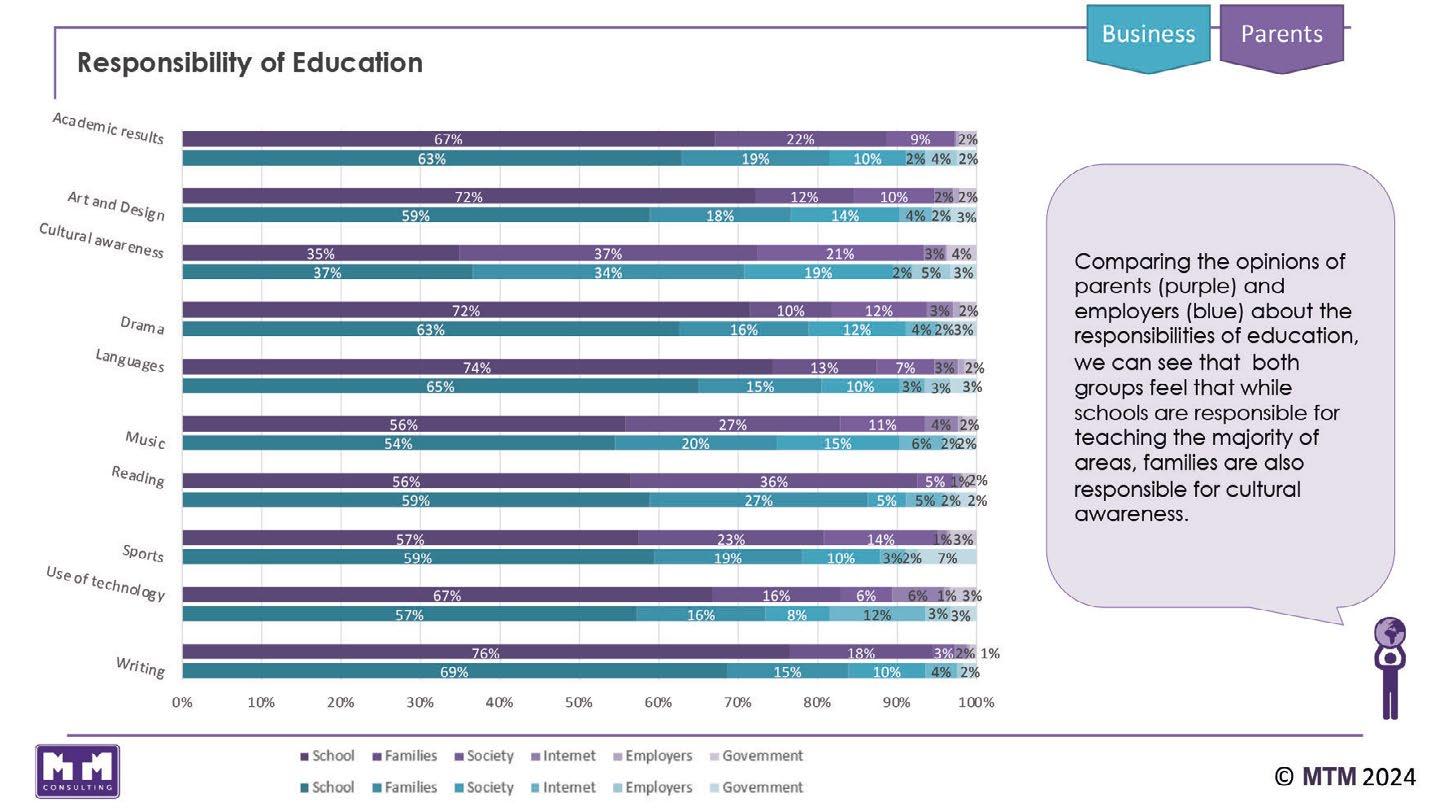
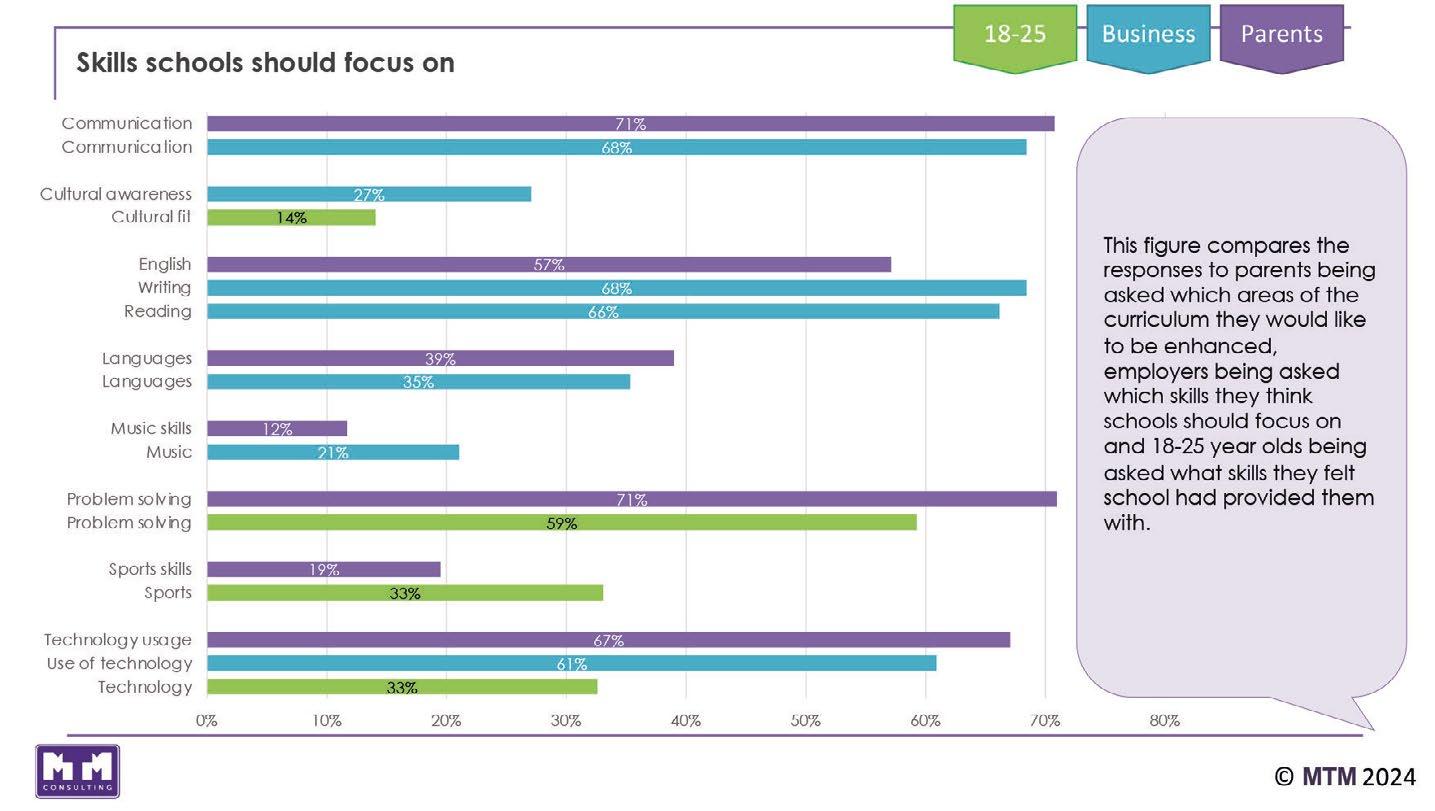


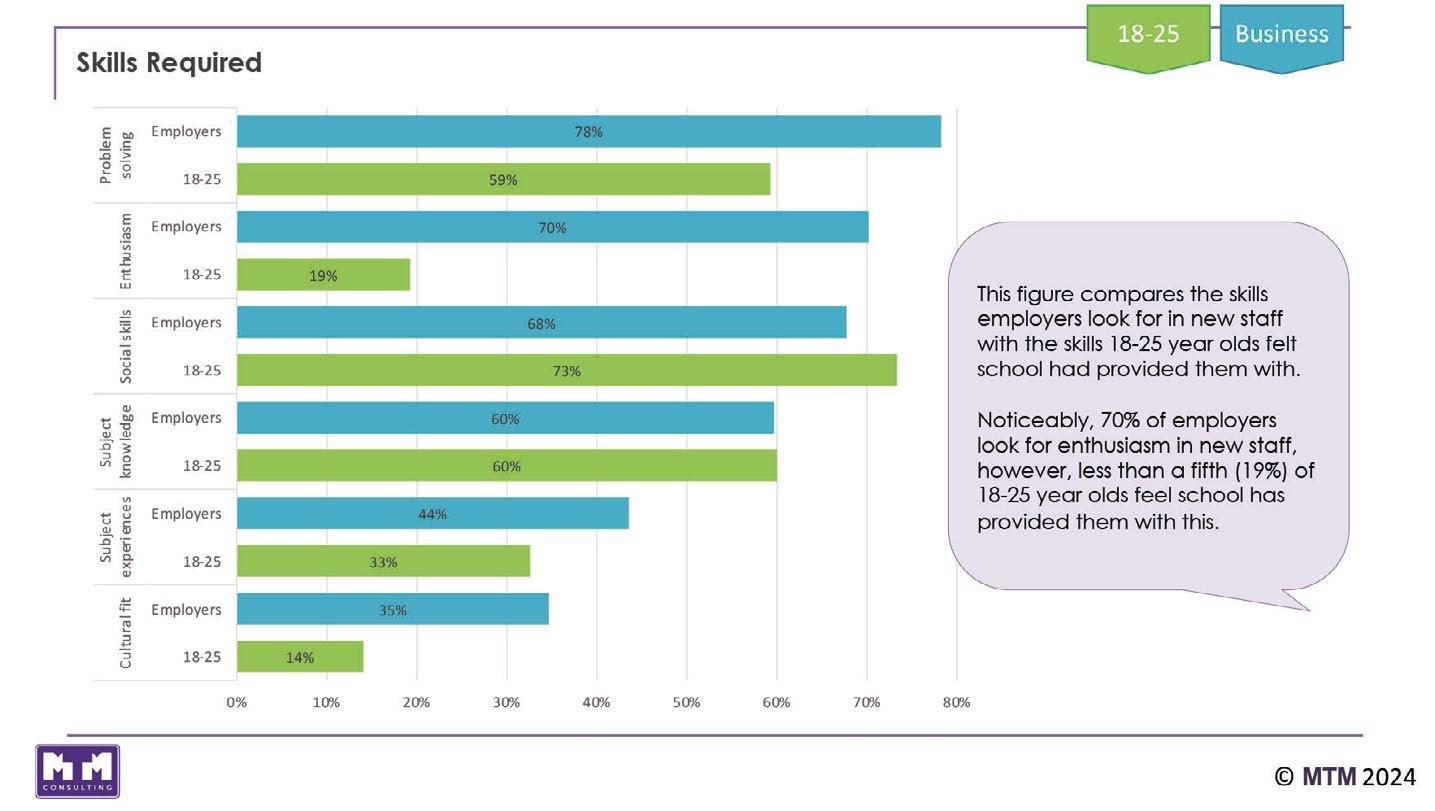
Yet participation in sports or other team-based co-curricular activities that schools might offer to deliver this ambition are given less credibility which points to the need for a much better understanding of the offer by the wider public.
• An ability to manage safe and skilful navigation of technology is unsurprisingly deemed to be an important factor by parents and businesses, while young people identify this skillset as one that schools could improve further in their teaching and learning.
• The concept of enthusiasm is rated as second only to problem-solving by businesses in terms of what they seek in their recruitment cycle; this is not reflected in the perception of young people as something that schools prepare them for hence there’s a pressing need for the coaching of attitude, motivation and interview technique to be placed within a suitable learning environment.
• Cultural fit is considered by young people to be an inadequate facet of school preparation for the real world; the need for a significant, added focus on the interpretation of British values and global citizenship to underpin academic learning, as well as their meaningful context for individuals
irrespective of their background, is paramount.
• Approximately half of parents and businesses believe that young people are prepared for the world of work in overall terms with a similar balance articulating a concern that the gap is growing between the needs of the workplace against what is being delivered by the education system.
• Young people want the education system to better reflect life skills such as financial literacy and digital mastery in addition to traditional academics.
• While there is seemingly less emphasis placed on the relevance of subjects studied by young people and the level of attainment achieved during their education, it is increasingly evident that genuine, vocational experience is garnering a much greater appreciation by employers.
The research was undertaken to discern the readiness of young people for life in the world of work; predicated upon the results, it is evident that a disconnect remains between parental opinion and the needs of employers set against the actual aspirations of young people and a general misconception of the education system at large.
Parents, employers and young people alike recognise the importance of communication and life skills, as well as problem-solving, for future success yet there’s a lack of understanding about how non-core, specialist subjects within the school curriculum can effectively harness these factors and deliver similar outcomes.
Young people are largely motivated by taking ownership of their future career in an autonomous manner, either by starting their own business or working more flexibly, with financial gain listed as a major contributary reason for their choice of career.
Authentic experience in the workplace together with the demonstration of soft skills, including resilience, is deemed


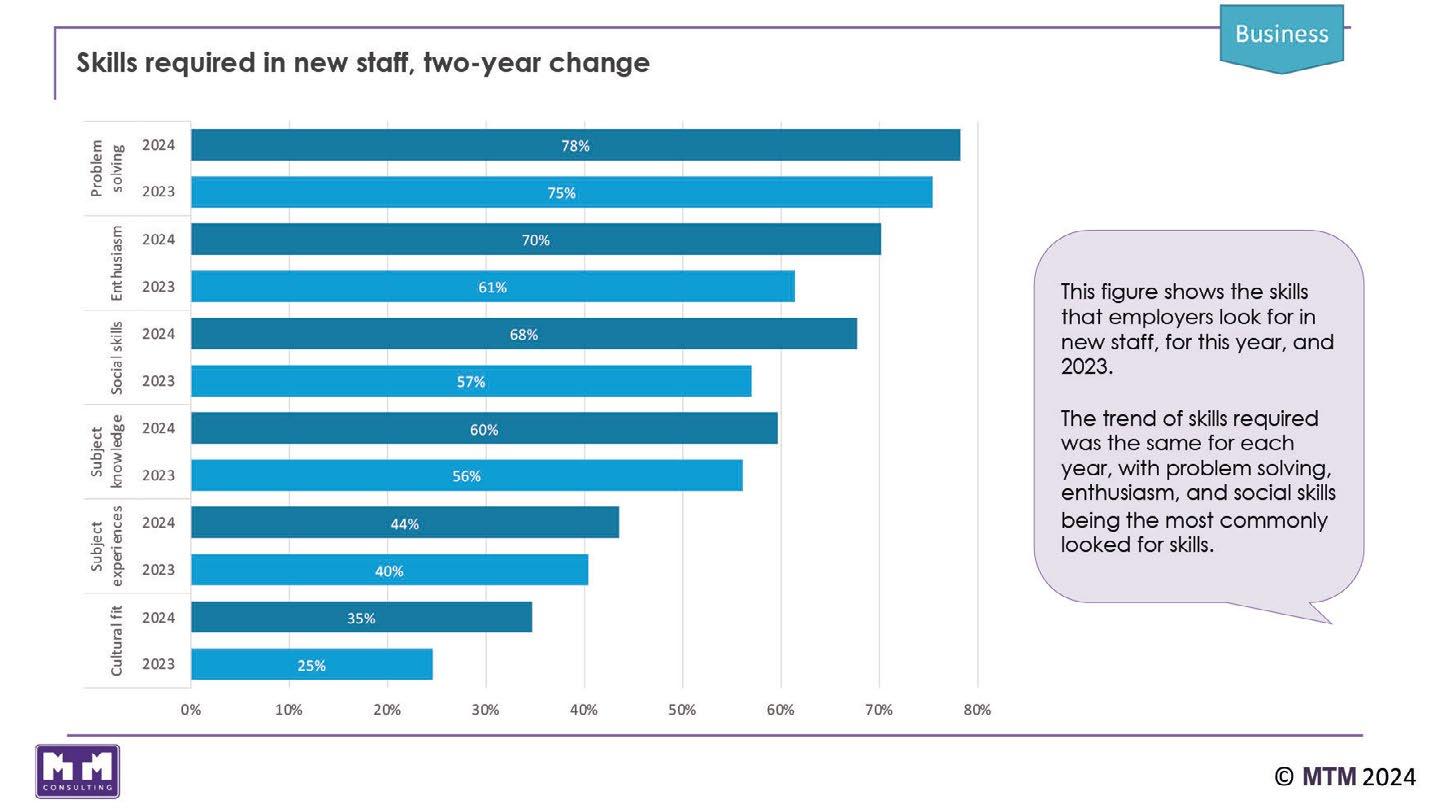


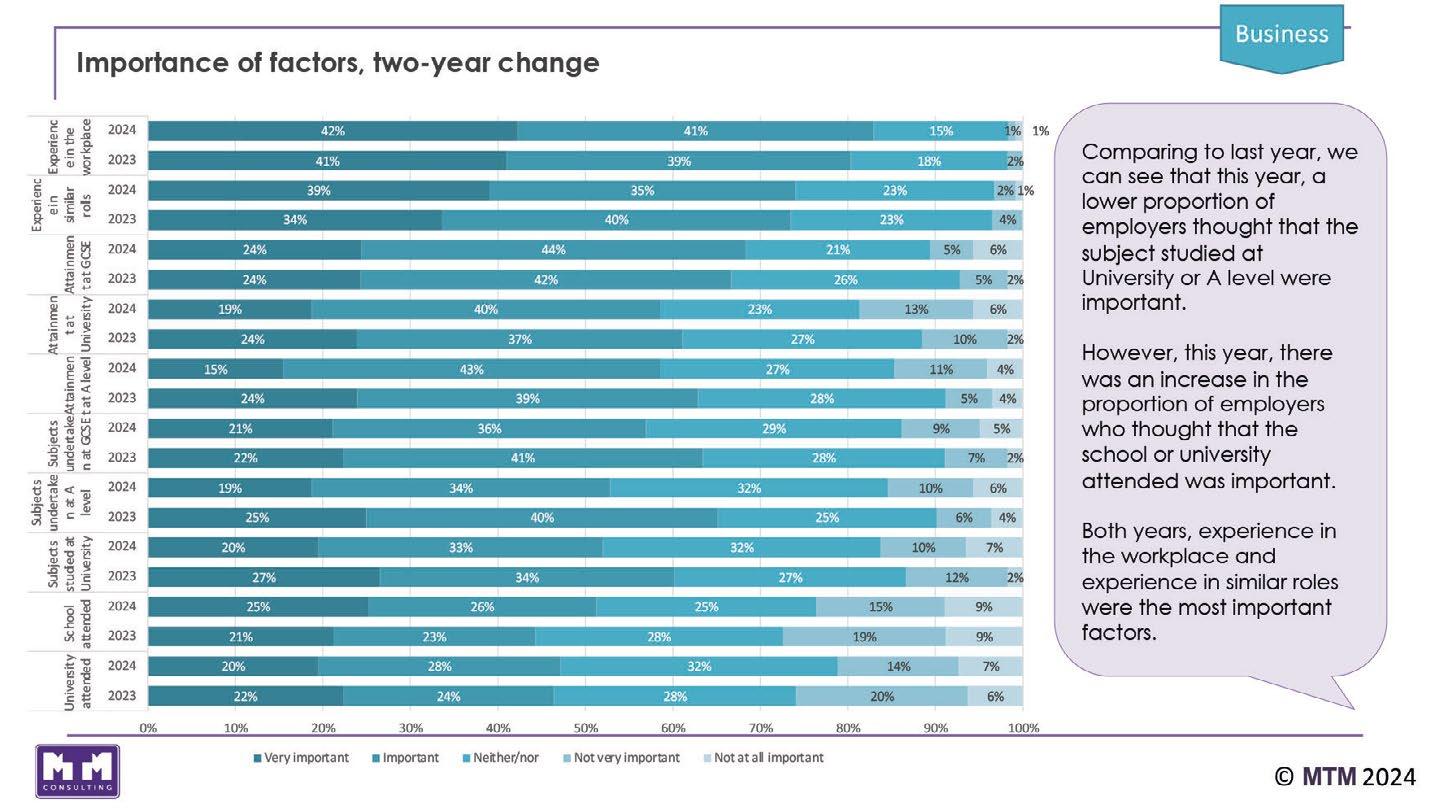
“Young people want the education system to better reflect life skills such as financial literacy and digital mastery in addition to traditional academics.”
more valuable by businesses in their recruitment of new employees than academic attainment, choice of subject or name of awarding institution.
Apprenticeships, work experience and interview practice should play a much more significant role in the education system and while both families and local employers currently feel isolated from the process, they are willing to give up time to share their knowledge and experience in support of a vocational evolution within schools and universities.
We hope that these salient points will transcend the political debate and spark a meaningful dialogue to procure tangible outcomes that will satisfy the aspirations of young people, service the needs of employers and enable a closer working relationship between home and school.
Duncan Murphy is director of education and strategy at MTM Consulting
Ian Allsop questions Independent Schools Council head Julie Robinson about VAT on school fees and other issues
The Independent Schools Council (ISC) has always been constructively vocal and fiercely supportive of its members, but in its 50th anniversary year, chief executive Julie Robinson has been busier than ever. Labour’s removal of the VAT exemption on fees for independent schools has gone from a proposal, to a manifesto commitment, to a concrete policy – with an earlier than expected start date of January – currently out for consultation.
Now that the focus moves on from fighting the policy itself to coping with its implications, what advice would Robinson give to schools? How, for example, can they further diversify their income to meet the challenge?
“It is hard for schools, but we recognise this is a policy the government is committed to. While we will continue efforts to oppose the policy on principle and press for exemptions and mitigation, schools need to prepare for January implementation. Budgets and fees will have been set for the next academic year, so schools and their families have very little time to review these and make adjustments.”
She says that the Independent Schools’ Bursars Association will provide updated guidance over the coming months informing schools of the practical steps they can take. “HMRC is expected to provide guidance too, since they have a large number of schools to register for VAT in a very short timescale. We
“Labour’s removal of the VAT exemption on fees for independent schools has gone from a proposal, to a manifesto commitment, to a concrete policy.”

encourage schools to maintain clear and regular communication with parents, ensuring all are abreast of the key facts and schools’ plans for the future.”
In the meantime, the ISC continues to engage with the government on the consequences of this policy for schools, families and communities. “In particular, pupils with special educational needs and disabilities, faith schools and specialist arts education.”
Robinson became general secretary of the ISC in 2015. Prior to that she was head of Ardingly College Junior School and then Vinehall Prep School, both in Sussex, before becoming education and training director for the Independent Association of Preparatory Schools (IAPS). At IAPS, she served on the standing group of teachers associations and the Independent Schools Examination Board. She also chaired the Independent Schools Council’s Cross Association Leadership Group. As well as leading ISC she now also serves on the School Partnerships Oversight Board for the Department for Education, promoting independent-state school partnership work, while liaising with influencers in education across
schools, government and the media, serving the interests of ISC constituent associations and member schools.
It has been argued in some quarters that some of the claims in sections of the mainstream press about the effect of the VAT policy have been exaggerated. Is there a risk that over-sensationalising it entrenches the ideological divide around ‘private schools’, rather than strengthening the very strong arguments around their invaluable role in overall education provision in the UK?
“The VAT on fees policy poses a very real threat to schools, and it is important to bring attention to those most at risk under the policy while challenging harmful stereotypes about independent schools and the families that use them,” she states. “It is also important that we do not create divisions between state and independent schools. All types of school have value across the education ecosystem, serving the children in their care. We share Labour’s goal of a great education for every child, and we’re keen to work with the new government to build upon the fantastic work already being done within the sector in the form of cross-sector

“We share Labour’s goal of a great education for every child.”
partnerships. These mutually beneficial programmes, which involve state schools, independent schools, charities and local organisations, provide valuable educational opportunities to children and young people across the country. “
The wider debate around the charitable status of independent schools has been bubbling away ever since Robinson first joined the sector. But is there a real fear that removal of charitable status will be the next major battle, even though this has for now been discounted by the government?
“Labour has said that while it no longer intends to remove the charitable status of independent schools, it will scrap business rates relief from those schools that have them from April 2025. Though this would not apply to all independent schools, it has implications for the charity sector more broadly. It
would create a two-tier charity system, setting a worrying precedent that any charity seen in some way as ideologically opposed to the government of the day could be subject to extra tax.”
While, obviously, the recent focus for ISC has been on countering the VAT policy, Robinson has also spoken out about other issues. Following the most recent set of A-level results in August, Robinson called on the government to focus on congratulating pupils for their achievements.
“This year’s school leavers will be the first in five years to have sat both their GCSE and A-level exams following disruption from the Covid pandemic. According to one forecast, up to 16,000 fewer top grades could be awarded if exam regulators “stick to their guns” and return grading to pre-pandemic levels after years of inflation. This would lead to the proportion of A*s and As falling to 25.4% – down from 27.2% in 2023 and 36.4% in 2022. I’m hoping it won’t be politicised, we need it not to be politicised – so I would hope that everyone from politicians to parents all just want to see children thrive.”
She continues: “I’m hoping that the focus will be on the success of those
pupils and the results of their hard work – these are the children that have come through Covid. They have not had an easy time – I’m fully expecting the focus to be on congratulating their results, whichever schools they’ve been to.”
And there are undoubtedly other issues for schools to deal with currently, although “the VAT on fees policy is the most pertinent issue facing the sector at the moment, and indeed threatens the success and survival of the many schools already operating on tight margins”. But on top of this, independent schools and their parents are still contending with the cost of living crisis and high energy bills. “Schools also face wage inflation including increasing teacher pension costs. Beyond financial challenges, schools are navigating a variety of topical education issues, including potential changes to the relationships, sex and health education curriculum, calls to ban mobile phones in the classroom, mental health concerns and debates over the use of artificial intelligence in exams and day-to-day school life.”
For Robinson, ISC’s half-century year will clearly continue to be a busy one.
Ian Allsop is freelance journalist.
The competition is hot, and an open day event is your main opportunity to sell your school says Katie Cardona
Affordability of school fees has long been a factor in pupil recruitment to independent schools. With VAT on school fees about to become a reality, attracting pupils to your independent school is likely to be more challenging than ever before.
An open day is a key marketing event and therefore plays a critical role in recruitment because it:
• Allows families to get a first-hand look at your school, to experience the culture and the facilities which are crucial to their decision-making process as to whether this is the right school for them.
• Serves as a valuable information gathering exercise in terms of the curriculum, teaching methods, extracurricular activities and pupil support.
• Allows prospective families to meet and interact with the staff and pupils which leads to a better understanding of the school community, and
• Above all, provides your main chance to demonstrate how your school meets parents’ needs and differentiates itself from your competitors.
Now is the time to take a close look at your open events to make sure they maximise the opportunity to showcase your school and demonstrate to prospective families why yours is the right school for them.
A successful school open day involves careful planning and preparation, so what do you need to consider?
“With VAT on school fees about to become a reality, attracting pupils to your independent school is likely to be more challenging than ever before.”
Is there a day and time that will suit everyone? Or do you need to offer alternatives? Research that we carried out with ISBI last year into earlier years showed that morning events were the most popular for families with young children. This is a very good example of how important it is to know your audience and have a deep understanding of their priorities and expectations. That way you will be able to tailor your open event to suit the families you wish to attract.
Are you going to ask families to register for the event or is it going to be an open house? We always recommend asking them to register as you then have the date you need for follow-up target marketing in the future, subject to data protection legislation.
You will need to create a detailed timeline for your marketing activity in the run-up to the event. In the current climate it’s likely that the objective of your open event will be to improve recruitment. Digital advertising is very effective in raising awareness of your open event and driving attendance. Targeted advertising campaigns on your social media platforms allow you to reach prospective parents based on their location, demographic and online behaviours, and analyse the results. Prospective families will go to your website to find information about the event and about your school so make sure everything there and on all your social media platforms reflects your main marketing messages and are up to date. Don’t forget more traditional media such as your local newspaper or radio station. There are plenty of free local event websites where you can share details of your open event. Banners, posters and flyers can also be put to good use in locations where you know prospective families will see them, such as cafes and venues where children’s events are held.

What your open event looks and feels like will depend entirely on your school, but it is important to make it an interactive event for the whole family.
If you are a prep school, and have a nursery, you will want to appeal to very young children and their families. In this instance, a themed open event can work well as it becomes a family day out and provides opportunity for meaningful and memorable interactions. Until recently, I was chair of governors at Rydes Hill Preparatory School and Nursery in Guildford. For the past few years our main open day in October, normally held on a Saturday morning, has been a themed event such as a teddy bear hunt. Visitors are given a map of the school and asked to find hidden bears in certain locations as well as engage in bear-related activities in the classrooms. On completion of their tasks all of the children are given a prize (a chocolate teddy bear, of course). Our experience is that parents and their children enjoy their morning at the school, levels of engagement are excellent resulting in high levels of interest in joining the school. Marketing a prep and nursery school to millennials will need to feature how you can fit into their busy lifestyles and provide the education and care they will expect, and that applies to the parents as much as their children.

The idea of theming an open event can also apply to senior schools. We worked with a senior school on its sixth form open event a few years ago, which was themed as a mini festival with bunting, hay bales and TEDx-style talks. Of course, this was when such festivals were emerging and current – it’s all about capturing the mood of the moment.
Whatever style of event you decide on, there are some key elements you should consider:
• Parents will expect a warm and
“Parents will expect a warm and informative welcome speech by the head of the whole school or the section you are focusing on.”
informative welcome speech by the head of the whole school or the section you are focusing on. This should set a positive tone for the event because they represent the ethos and values of the school. The content of the head’s talk should include material pertinent to the parents, as well as the potential future pupils in the audience.
• Ensure that there is ample information provided on all aspects of school life and showcase outstanding achievements in academics, sports and the arts. Parents will be looking for information on your pastoral care too, so be sure to have the head of pastoral available to talk to the parents and maybe the school counsellor, or nurse, to provide information regarding mental health support.
• It’s crucial to demonstrate to prospective families that you offer value for money. Your open event is the perfect opportunity to communicate your provision and set out how this differs from your competitors. Some prospective parents may also ask about the strategies you have in place to
ensure the sustainability of your school and indeed its green credentials.
• Many schools offer guided tours led by pupils or staff. If the pupils are the tour guides, it’s important to have a mixture of high achievers and those who find learning more difficult. The key is that all of the pupil tour guides need to be confident and able to talk positively and enthusiastically about the school.
• Demonstrations and performances in the fields of sport, music and drama are an excellent way to display the talent of your pupils. On a recent open day mystery shopping visit, we were delighted to enter the music department and hear sublime piano playing. The school had rightly chosen a very talented pupil pianist to be present and the result was impressive. So often we have visited silent music departments, which sends out such a negative message and is very disappointing.
• Review your signage and directions throughout the site so that visitors can
“Review your signage and directions throughout the site so that visitors can find their way easily.”
find their way easily. If you need to create some temporary signage make sure it follows your brand guidelines and looks polished. Photocopies will not send out the right message.
• Ensure the comfort of your visiting families by providing top-quality refreshments. Enlisting a local cafe to provide great coffee and croissants goes down well with parents (especially on a Saturday morning) and shows that you support your local community and independent traders.
• A small point but nonetheless very important – make sure the lavatories are clean and tidy. Parents often view the condition of these as a representation of how well you look after the whole school and many
parents now expect hotel-level quality in your reception area.
• Consider offering a creche for younger siblings so that parents can fully enjoy their visit and little ones have a lovely time too.
The main thing is to thank all of your team involved for the hard work they have put into promoting the school. Remember to include those who may not have been there on the day. And thank the families who attended. If you have their contact details via the registration form you can follow up with a short digital survey to ask for their impressions and any suggestions for improvement. You can also talk about the next steps for them and any additional information they might need.
Remember that parents will use an open day as one of a number of decisionmaking factors taken into account when choosing a school. They will also look at inspection reports, internet chat platforms and talk to current parents and staff at your school. Therefore, you need to make sure that all of these channels represent your school in a positive light.
Open events have always been important for recruitment, effective communication, relationship building,
decision-making and raising awareness of your school for prospective families and the wider community. Now, as families face additional financial pressure when deciding whether they can afford an independent education for their child, open events will become even more significant to your marketing and admissions functions. We appreciate there’s a lot to think about, but hopefully this advice will help your school to offer a welcoming, informative and engaging open event that leaves a positive and lasting impression for prospective families.
Katie Cardona is a consultant with Reed Brand Communication
“Remember that parents will use an open day as one of a number of decisionmaking factors taken into account when choosing a school.”


Cheadle Hulme School has appointed Lee Richardson as its new headteacher, About Manchester reported.
Cheadle Hulme School is a co-educational private day school for pupils aged three to 18.
Richardson has more than two decades of experience in teaching and senior leadership at Cheadle Hulme. He joined as an economics teacher in 2000 and was promoted to head of economics and business, then becoming deputy head and senior deputy head.
Richardson said: “As the new headteacher, I pledge to build on our strong foundation of mutual respect, care, tolerance and kindness for every pupil – and, of course, excellent academic results.”
Ellesmere College in Shropshire has appointed Jonathan Shaw as its next headteacher from September next year, the Oswestry and Border Counties Advertizer reported.
Ellesmere College is a co-educational boarding school for children aged three to 18 owned by the Woodard Trust.
Shaw is currently head of the senior school of 600 pupils at King’s Ely in Cambridgeshire. He was previously a housemaster at Woodard Trust-owned Ardingly College Prep School in Haywards Health in West Sussex. He was also vice-principal of pastoral at Elizabeth College in Guernsey and head of boarding at St Andrew’s, Turi in Kenya, where he was also chairman of marketing. Before that, he was head of history at Gordon’s School in Surrey and a history teacher at Royal Grammar School (RGS) Worcester. He has also worked as an inspector for the Independent Schools Inspectorate.
Ellesmere College’s headmaster for the past 27 years Brendan
Wignall died in January from cancer. Vicky Pritt-Roberts will continue as acting head of until Shaw takes up his post. Shaw said: “During my recent visits to Ellesmere, I was particularly impressed by the school’s care for the individual, the importance of the community and the sense of ambition for the future.

“It will be a huge privilege to build upon the legacy of Brendan Wignall who led the school with such humility, kindness and wisdom.
Newcastle High School for Girls (NHSG) has appointed Lesley Moody as chair of its governing board, succeeding Patricia Alexander who has spent seven years as chair and 11 as a board member.
NHSG is the only Northeast school of the Girls’ Day School Trust.
Moody has been vice-chair of the school’s board. She is the managing director of AES Digital Solutions and a past president of North East Chamber of Commerce. She has previously been a member of several school boards.
Moody said: “Having been a governor at NHSG for five years with Patricia as chair, I know I am stepping into big shoes and am very much looking forward to taking up the mantle of supporting the school as it goes from strength to strength. I’ll be chairing a board of very committed governors with a wealth of experience and expertise and I am looking forward to working with them, NHSG’s head, Amanda Hardie, and the senior team as it delivers on its vision to champion excellence in all-girl education and provide an exceptional education for girls in the Northeast.”
Hardie commented: “I have been working closely with both Lesley and Patricia Alexander as we make this transition. I’d like to take the opportunity also to thank Patricia for her dedication, wisdom and her support as she helped steer NHSG over the last 11 years; she really has been phenomenal, and I know that her legacy is in such good hands with Lesley at the helm.”


Edward’s Senior School
St Edward’s Senior School in Cheltenham, Gloucestershire, an independent co-educational school, appointed Anna SandfordSquires as its headteacher.
St Edward’s is a member of the Alpha Schools group.
Sandford-Squires replaced Matthew Burke who departed to become headmaster of Beaulieu Convent School, an independent Catholic girls’ school in St Helier, Jersey.
Sandford-Squires has a master’s degree and PGCE from Cambridge, a master’s in educational leadership from Leicester, and an MBA from the London School of Economics. She has worked in various senior roles within the education sector for 20 years and was previously deputy warden at Llandovery College, a co-educational boarding school in Carmarthenshire.
Sandford-Squires said: “I feel deeply honoured to be able to lead St Edward’s and I am very excited about the future. From the moment I arrived at the school, I experienced first-hand the unique atmosphere, warm community and spirited ethos.”
Ali Khan, chief executive at Alpha Schools said: “Anna stood out with her blend of warmth and incisive, articulate understanding of education and I am very much looking forward to working with her. We have exciting times ahead of us as we continue our pledge to invest in improving the schools’ facilities.”
Burke said: “I have gained so much from leading this phenomenal community and have much to be grateful for as a result of my time here. I wish new headteacher Anna all the best and know St Edward’s is in capable hands.”
As well as continuing to analyse and advise on the latest position regarding VAT on fees, we will be covering plenty of other less well-publicised topics that school leaders should be aware of, including:
Mergers: A special focus on the various models that can help ensure sustainability, including what to be aware of when selling a school into a group; considerations for smaller schools; and an overview of the softer, non-legal considerations governors and school leaders should bear in mind when considering a merger.
Debt-collection: At a time when fees are more important than ever, how can you best secure any that are outstanding?
Leadership: How can you make your school more commercial, without undermining its ethos as an education provider?
Attendance: Will recent updated regulations around fines affect you?
Discipline: We explore dealing with issues around conduct. Schools are under greater scrutiny than ever before and, as a consequence, there has been a marked increase in the conduct of internal investigations, caused by either an external complaint or by an institution uncovering potential wrongdoing itself.
Employment legislation: A round-up of proposed changes in the King's Speech, and their potential impact upon schools.

Pension schemes: What do you need to know about the current rules on the teachers' pension scheme, and can you think about withdrawing?
Plus, finance for heads, governance, IT, and an interview with the head of Lord Wandsworth College.
And all of the latest news, people moves and more.
We are a family owned and run, fresh food contract caterer since 1989. With over 100 years of collective expertise in delivering fresh, bespoke food with fabulous service. We combine innovation and creativity to ensure your catering is vibrant and fun, yet healthy too.


